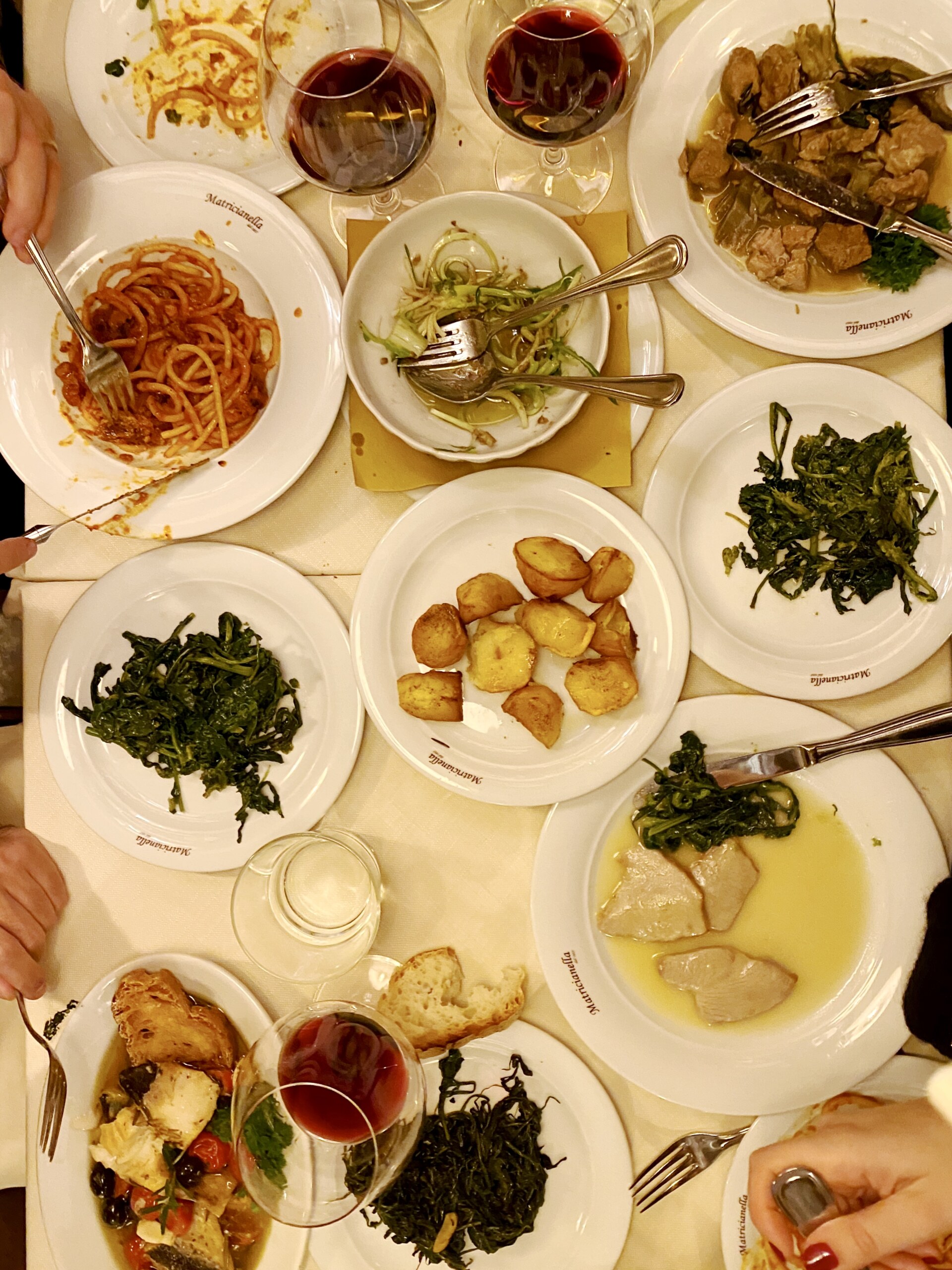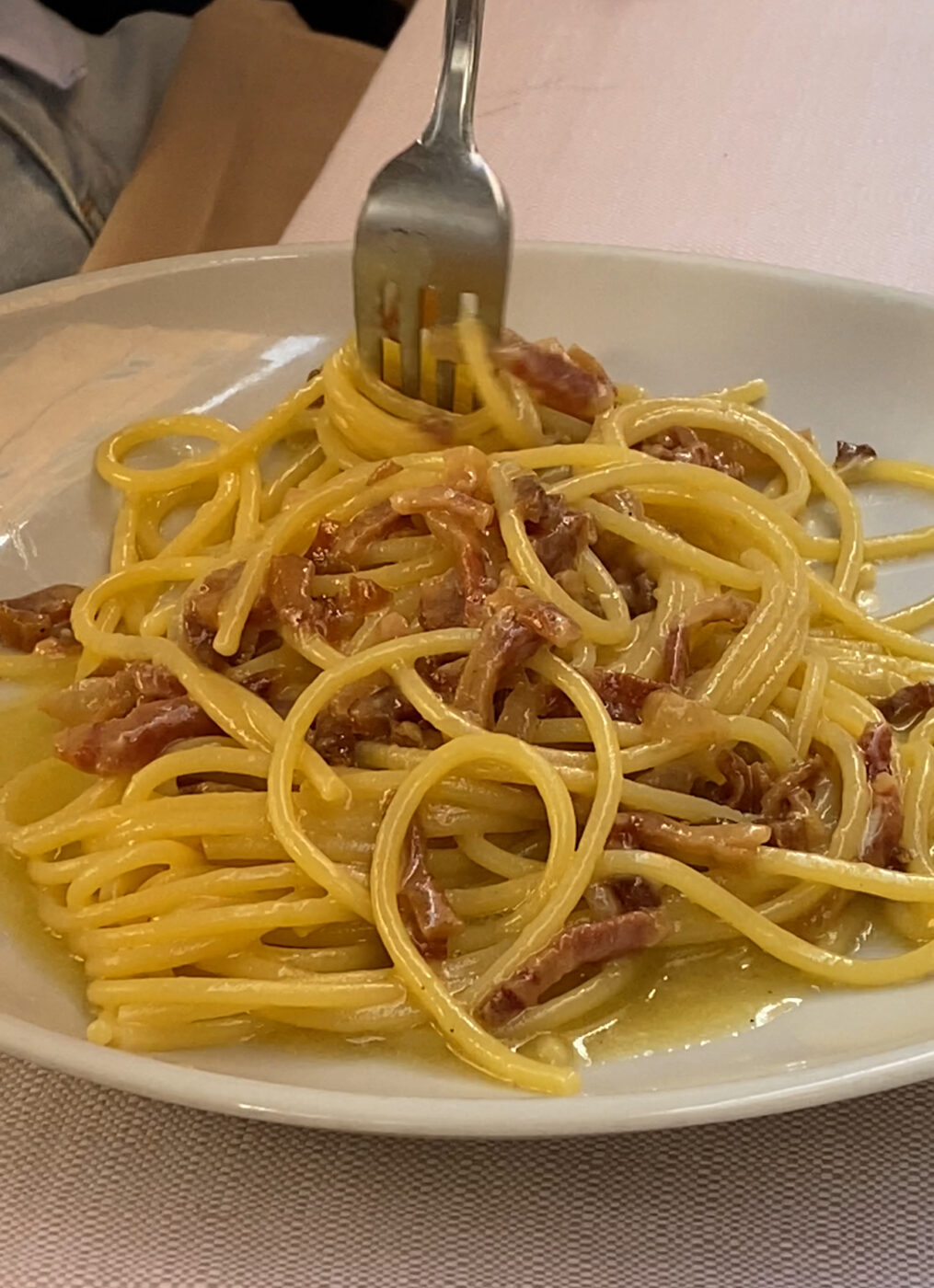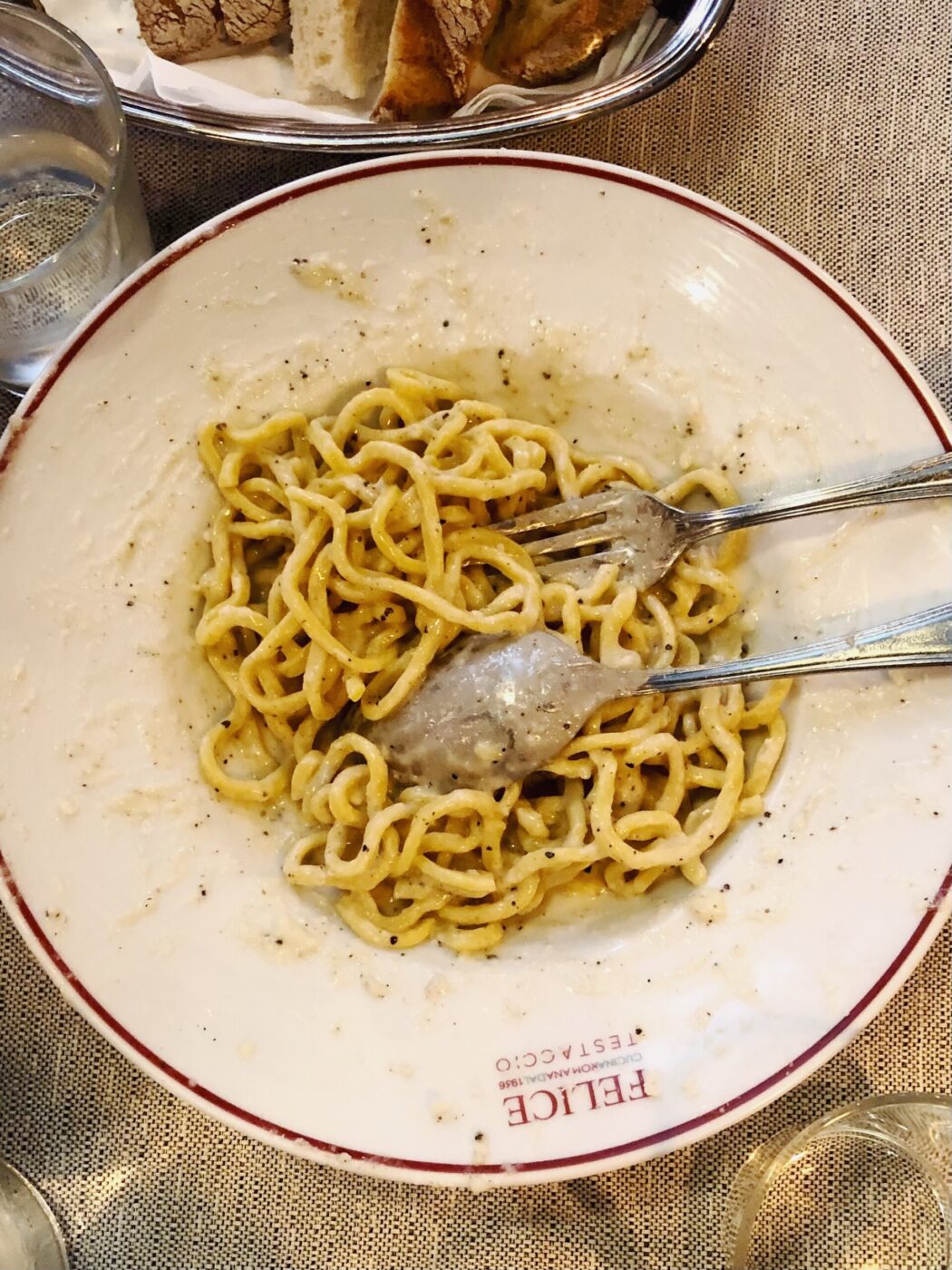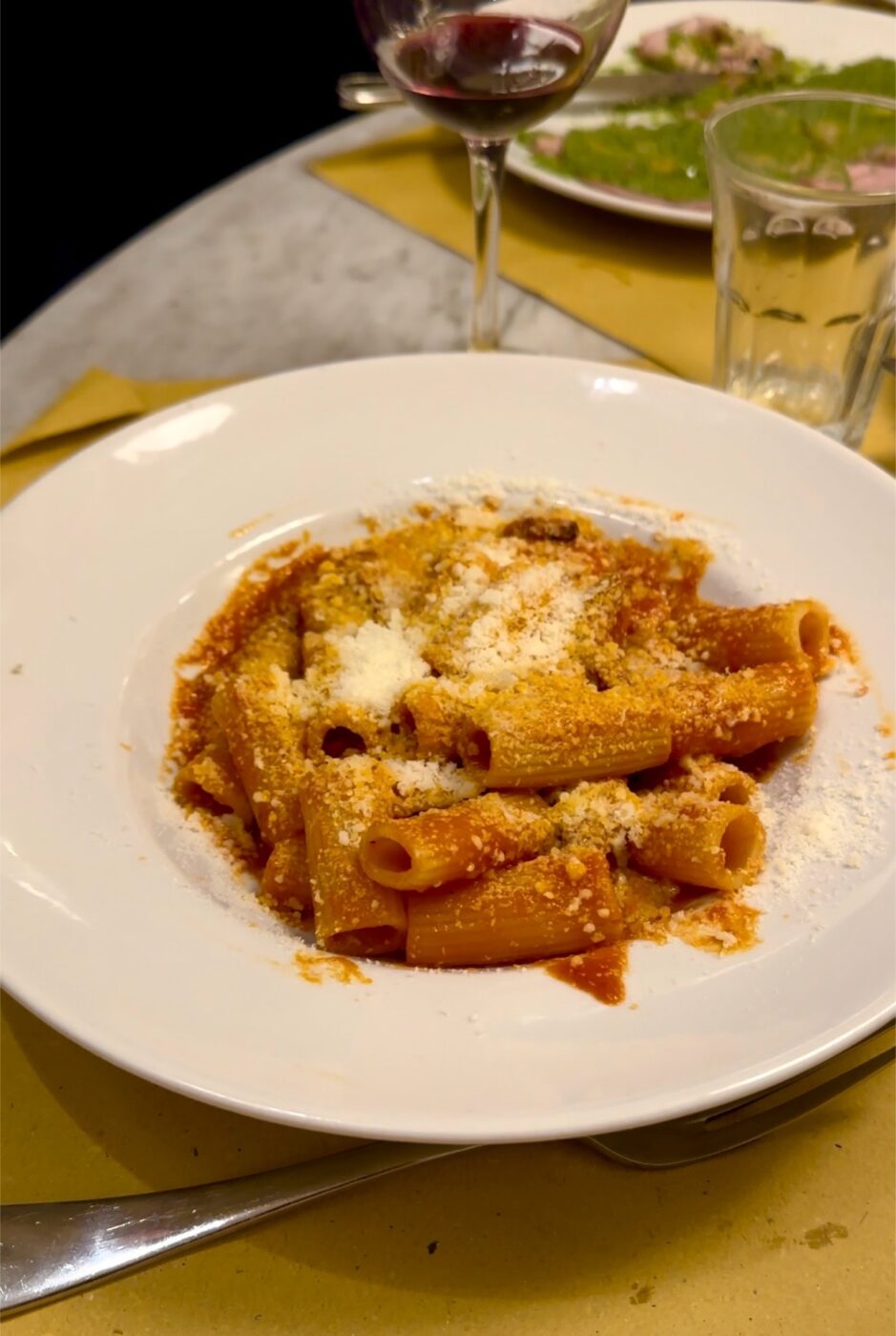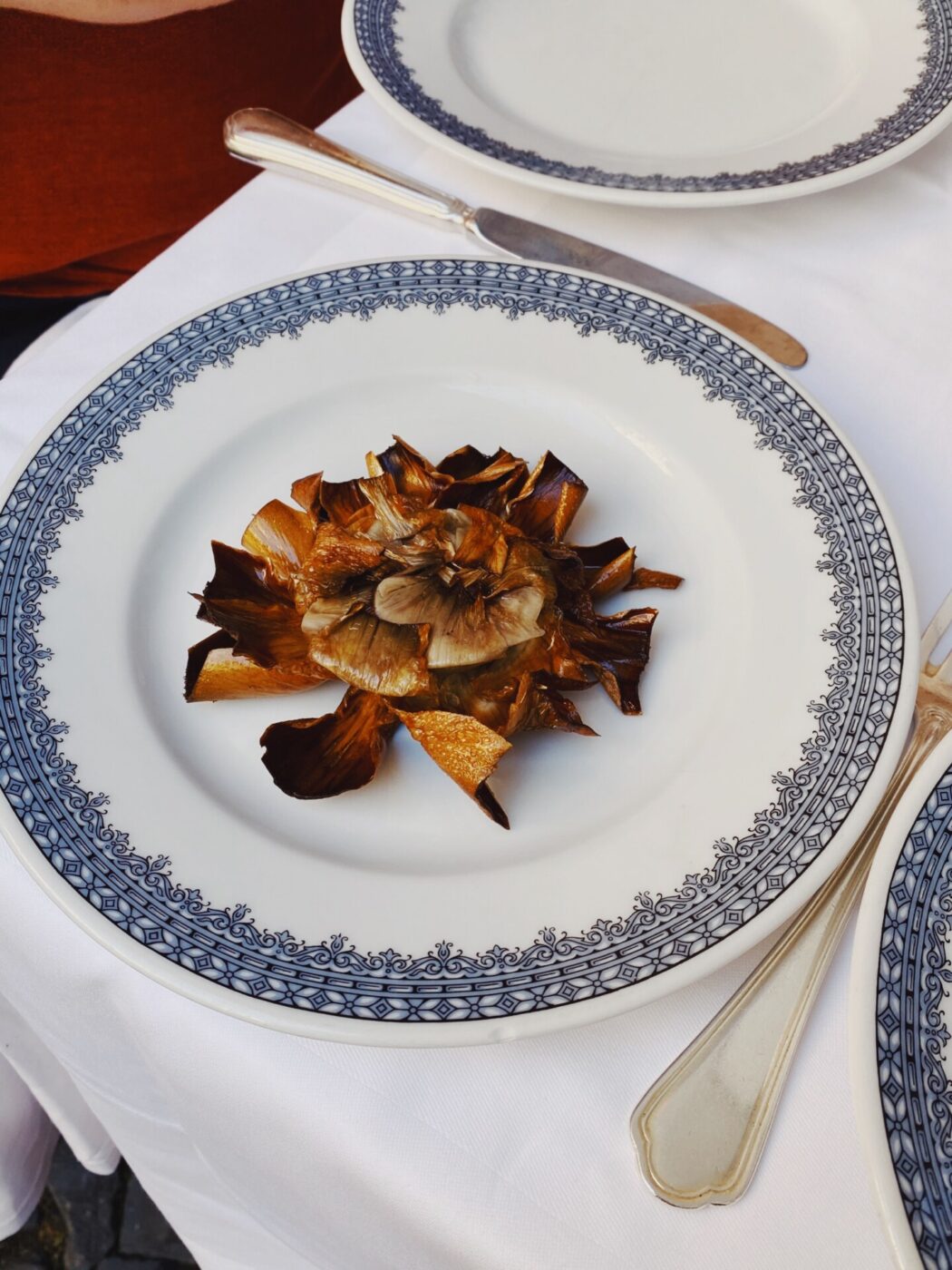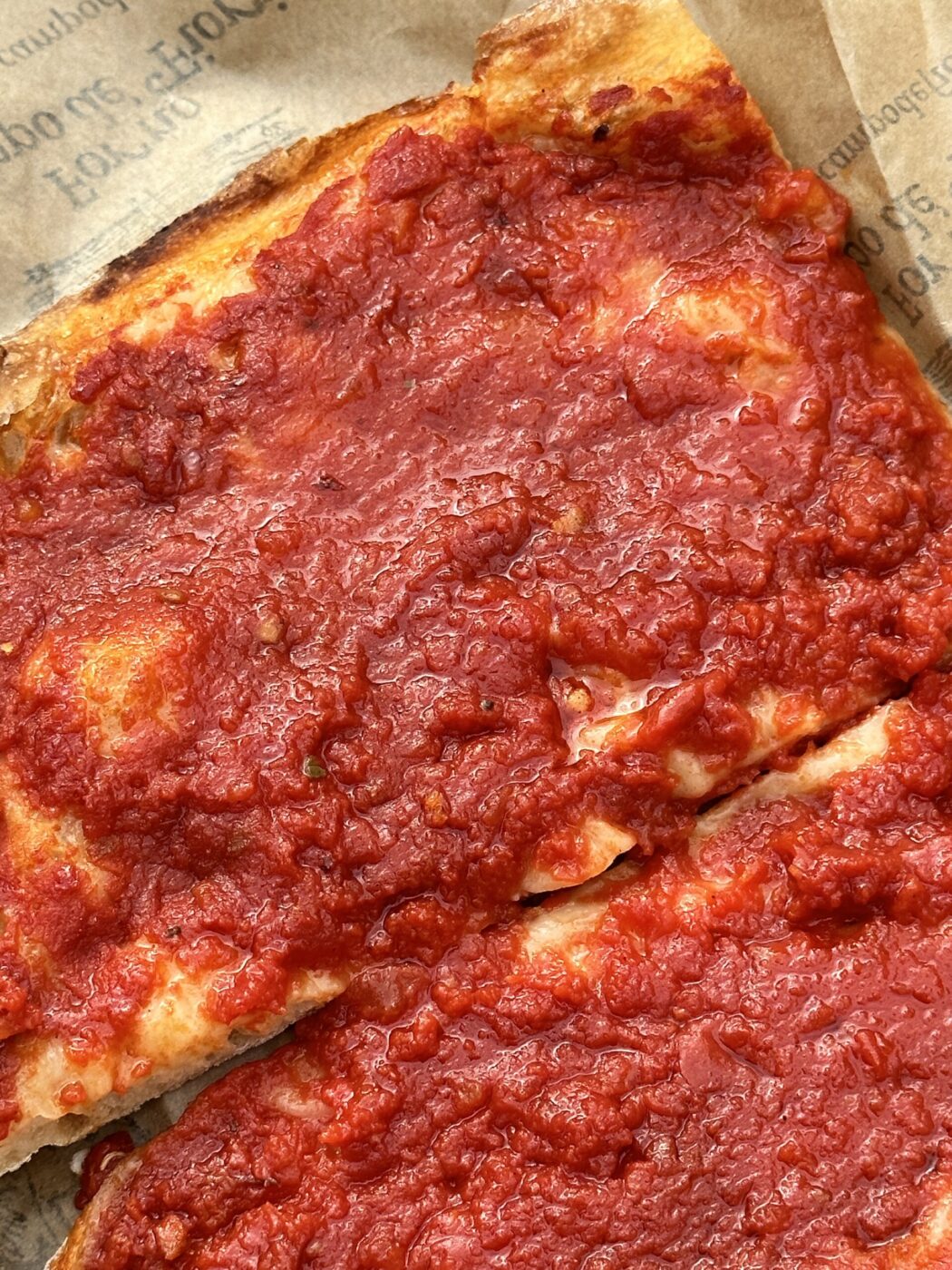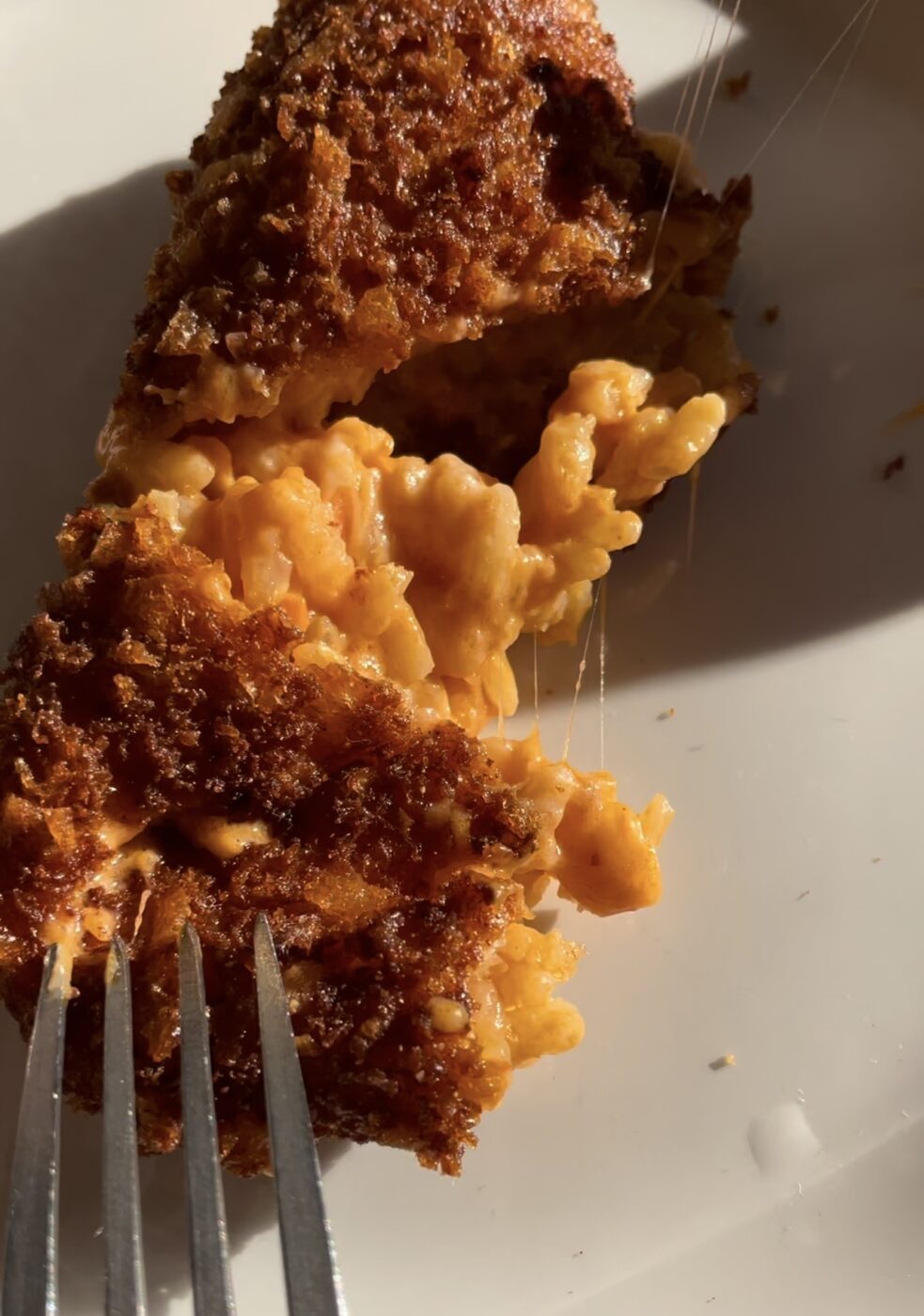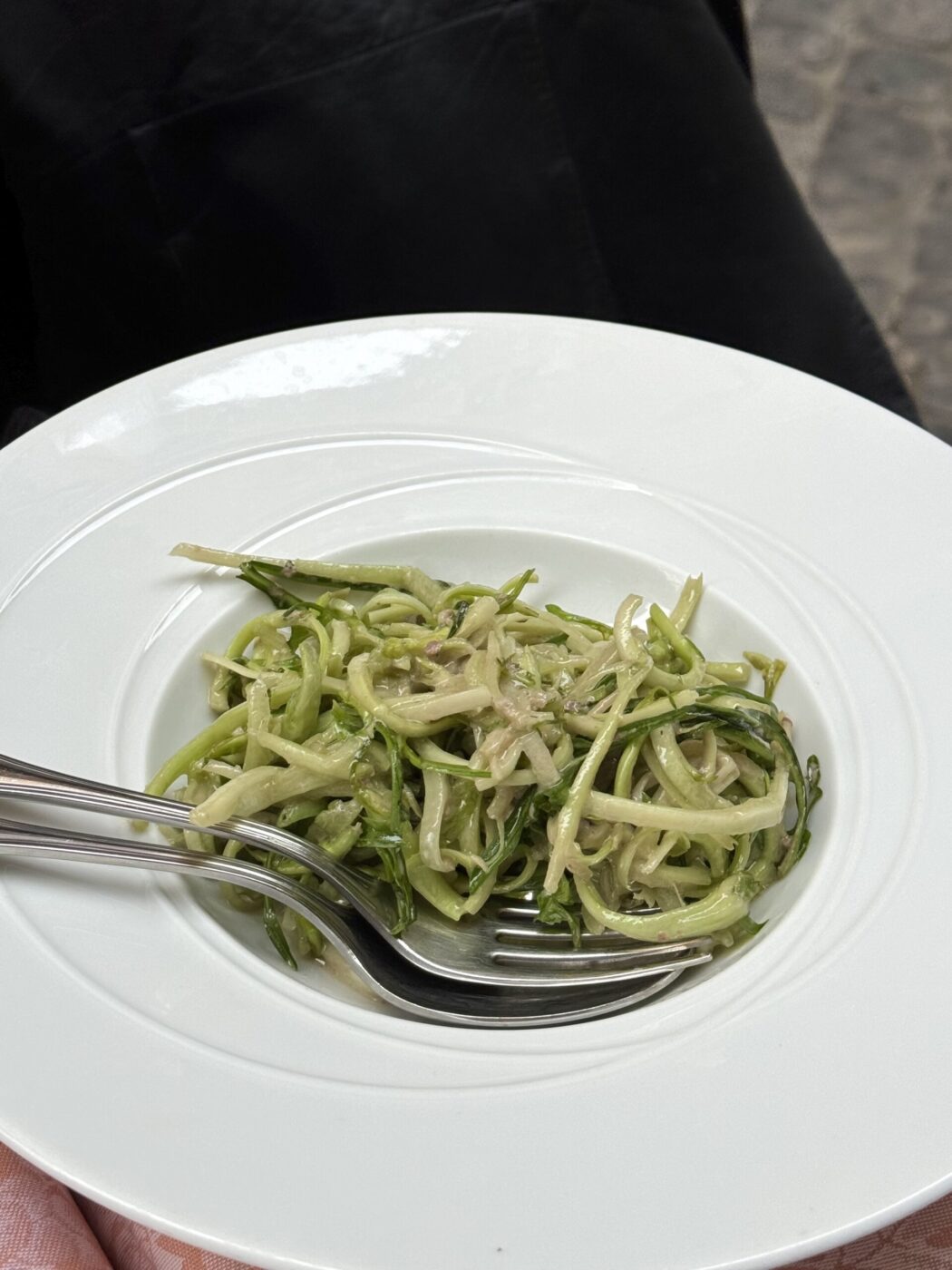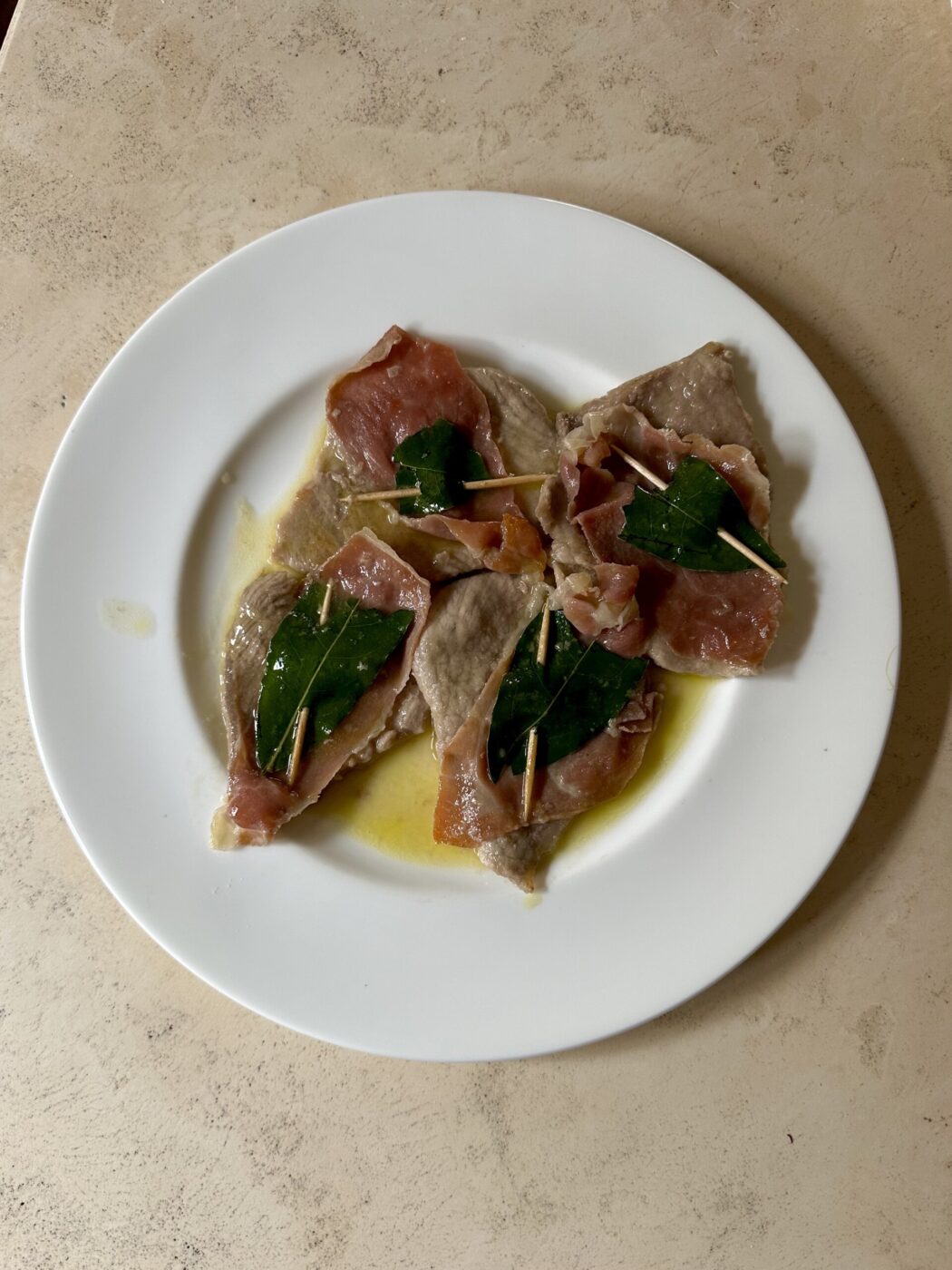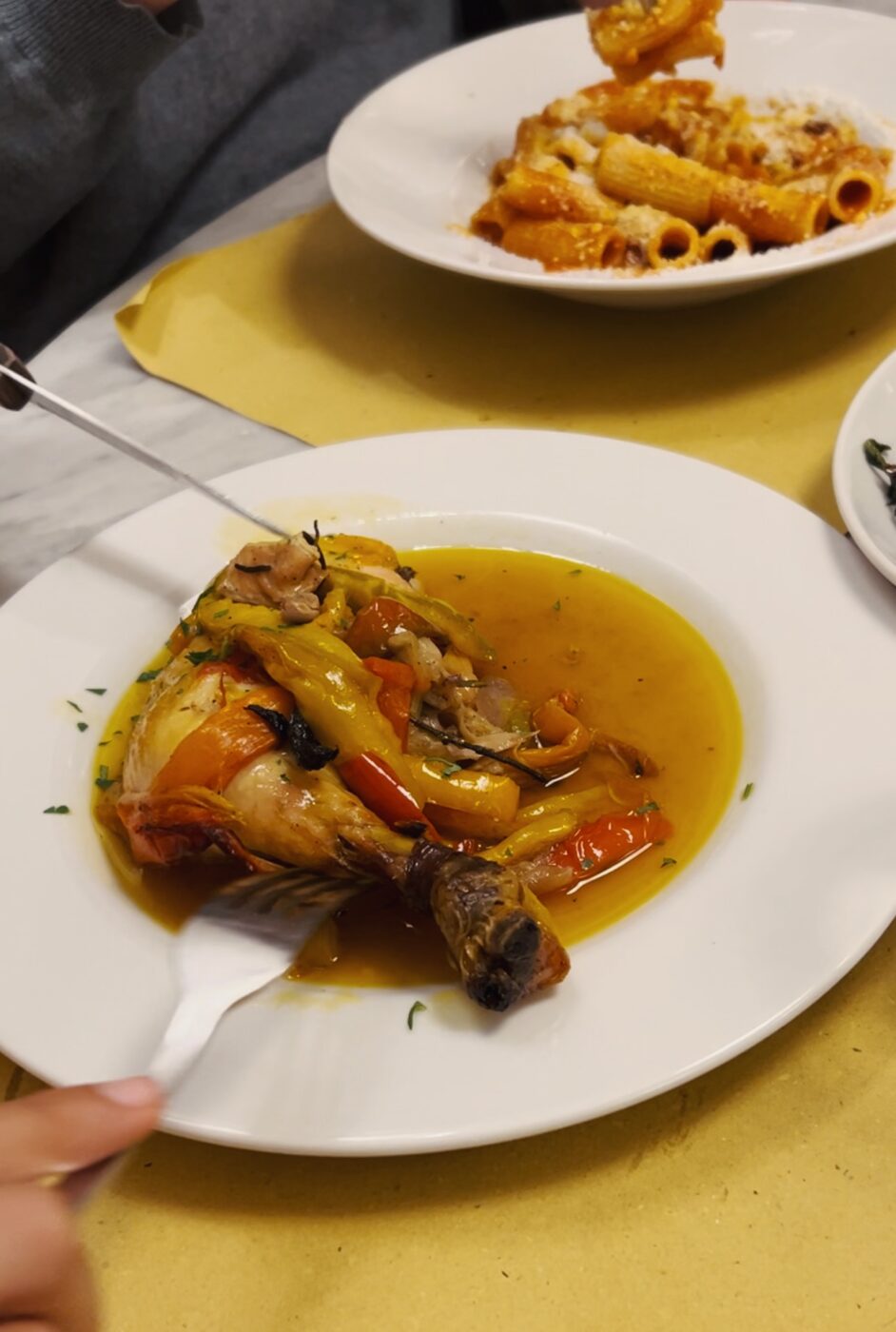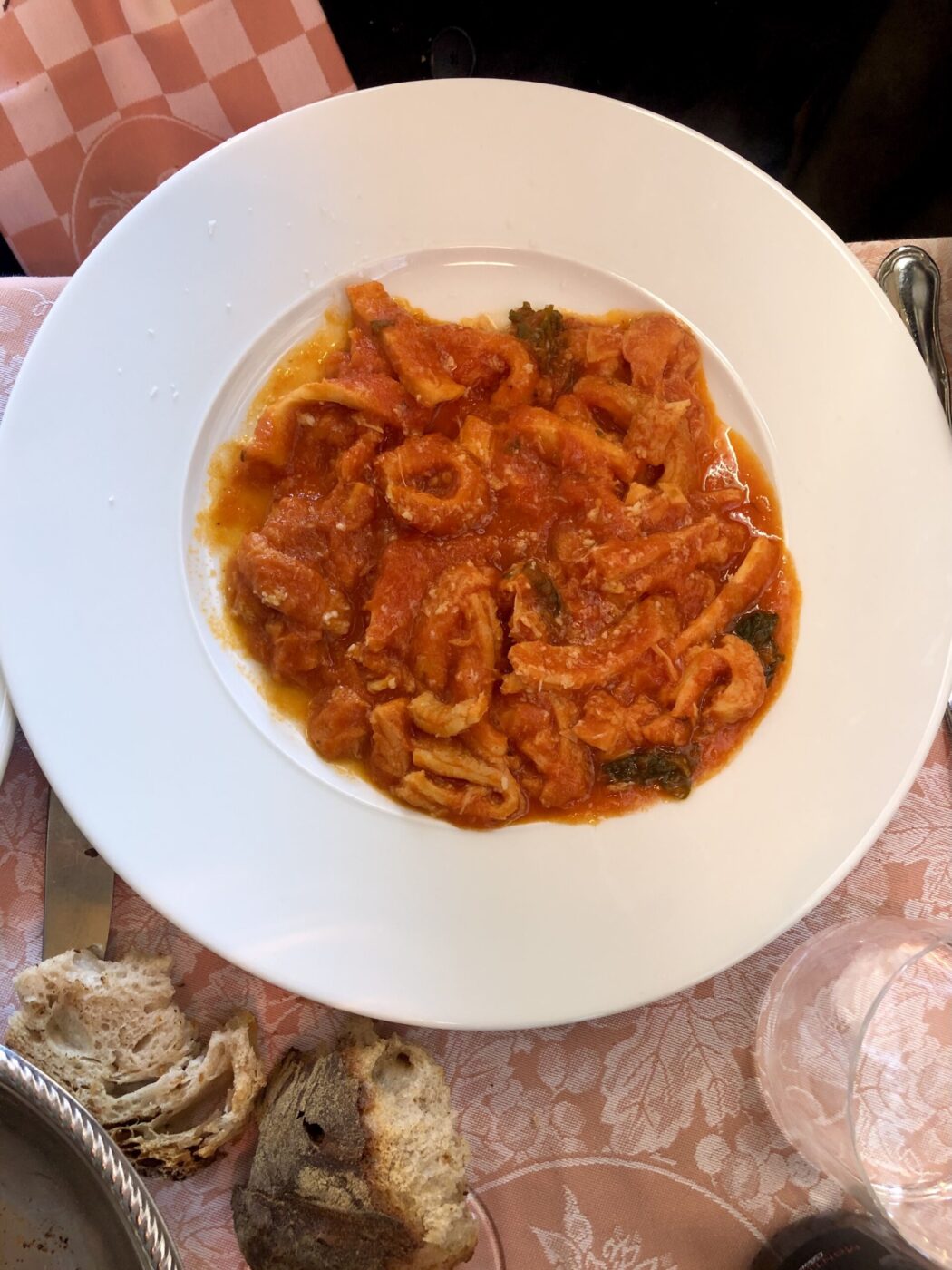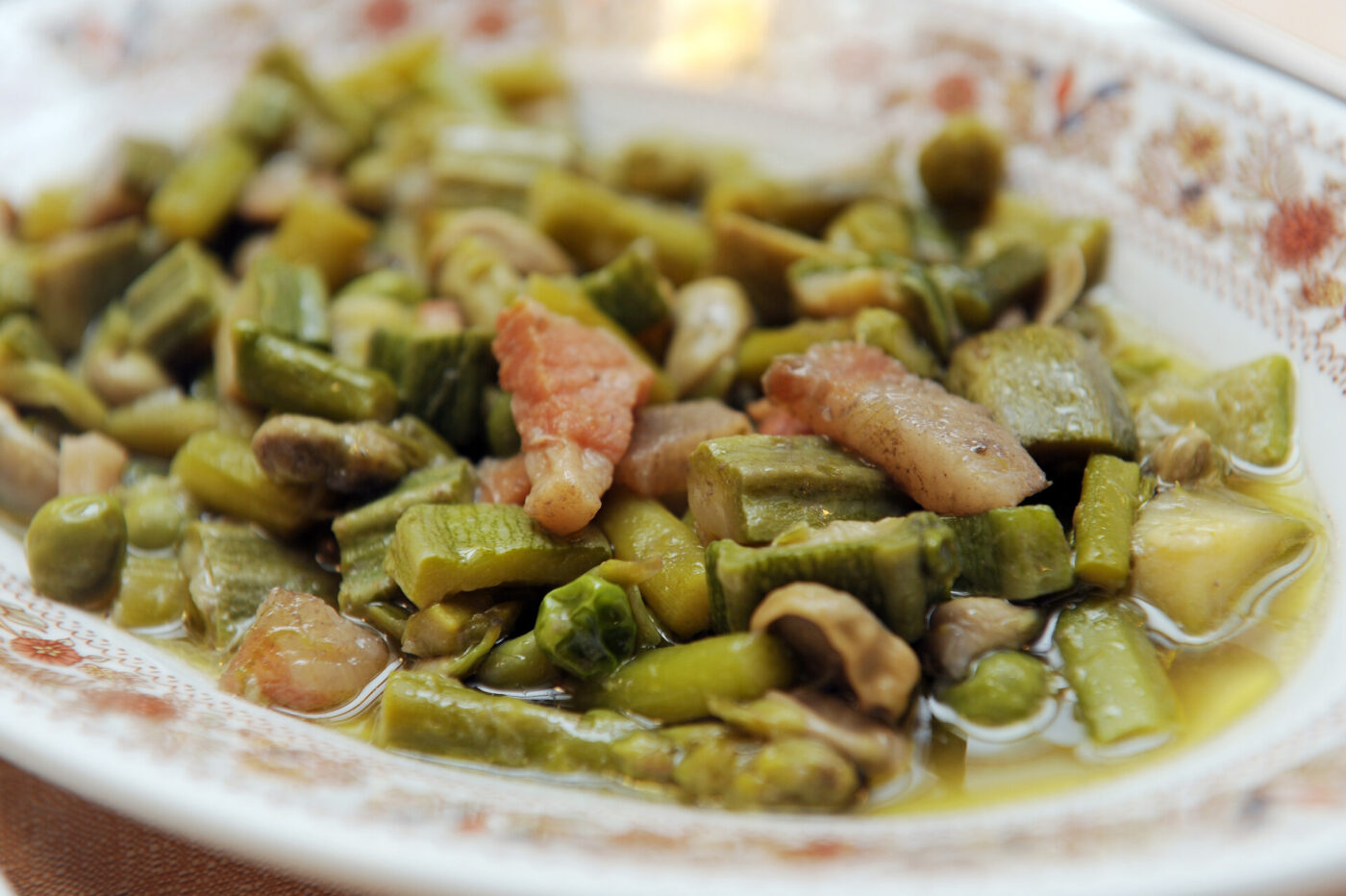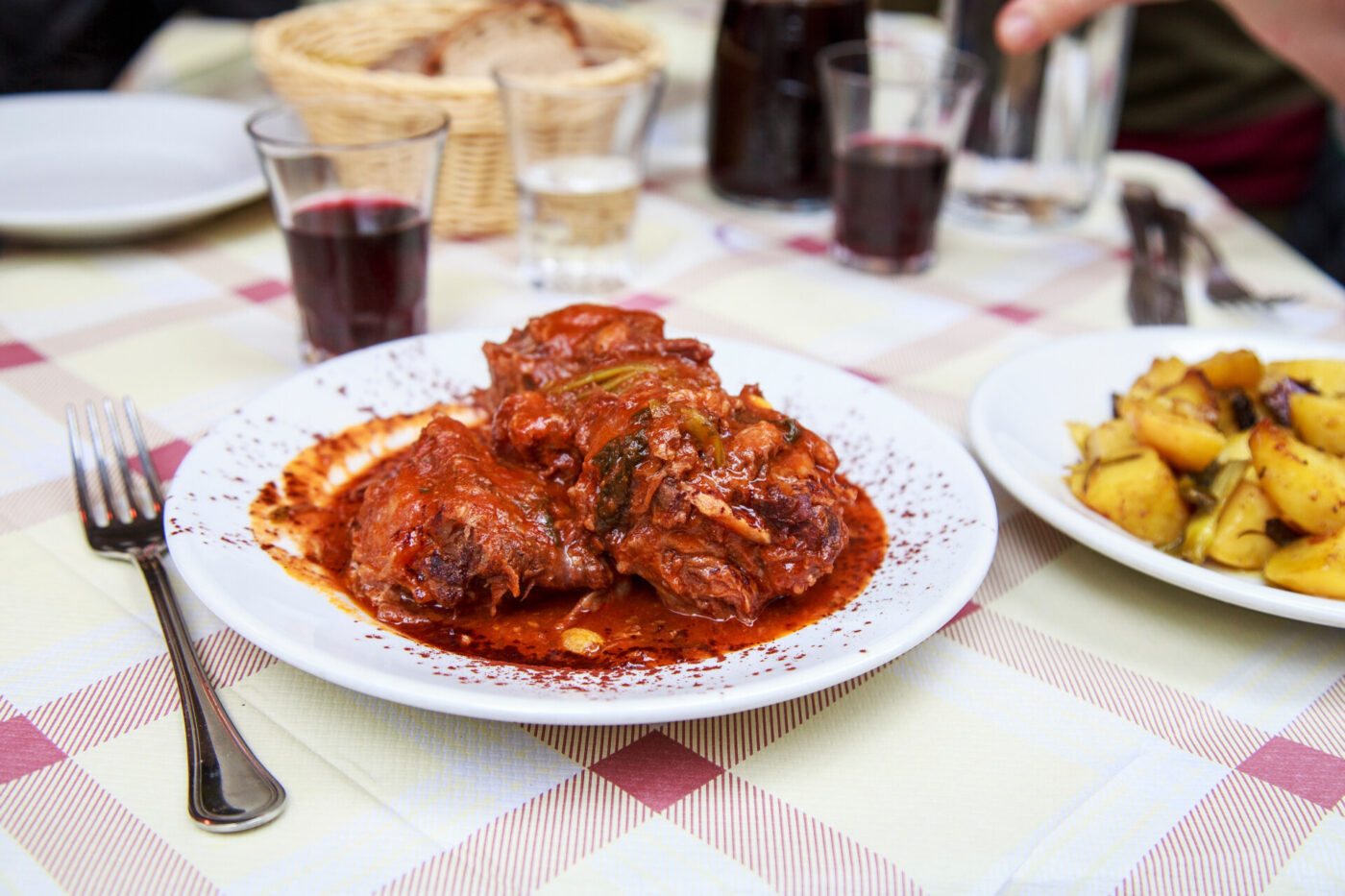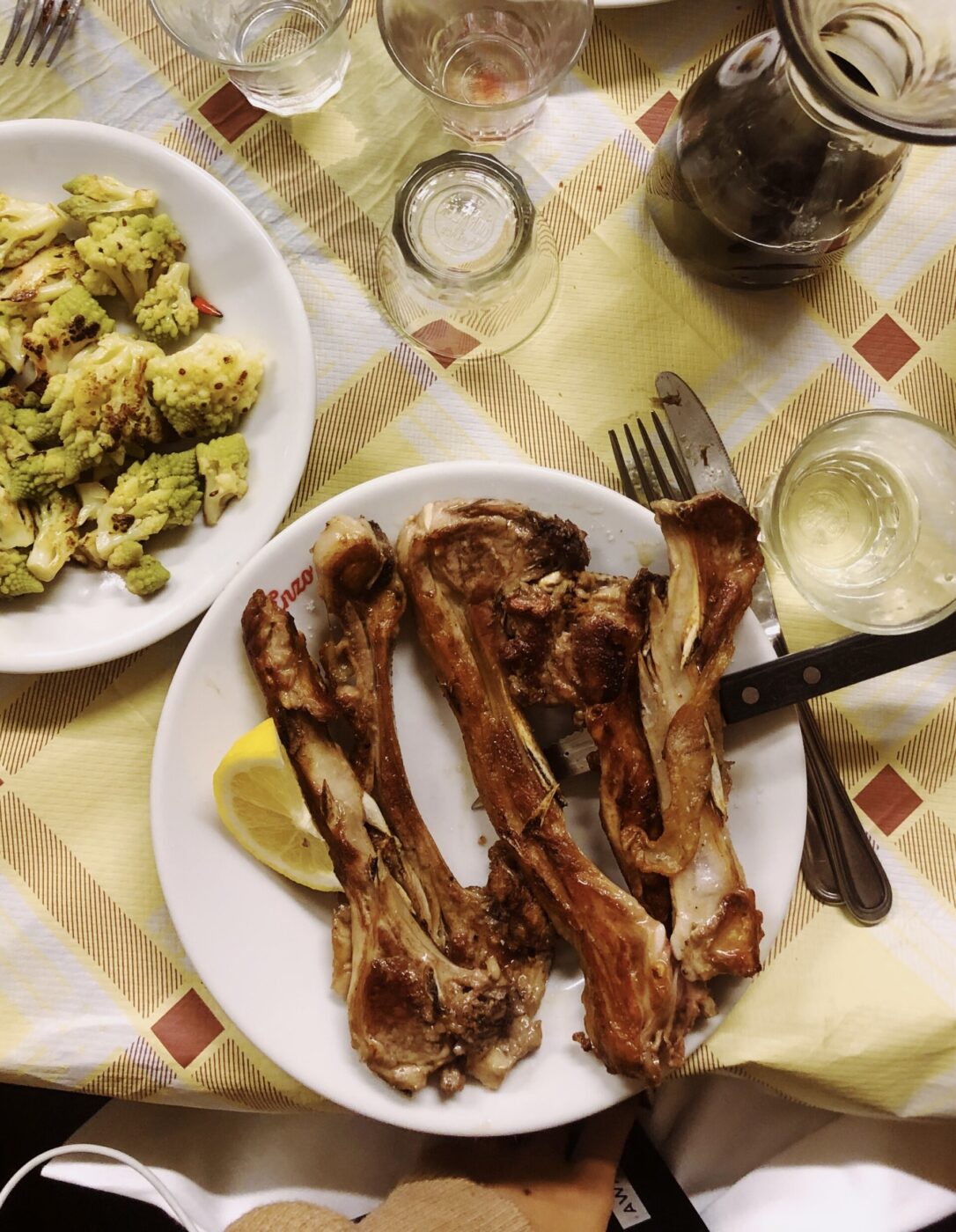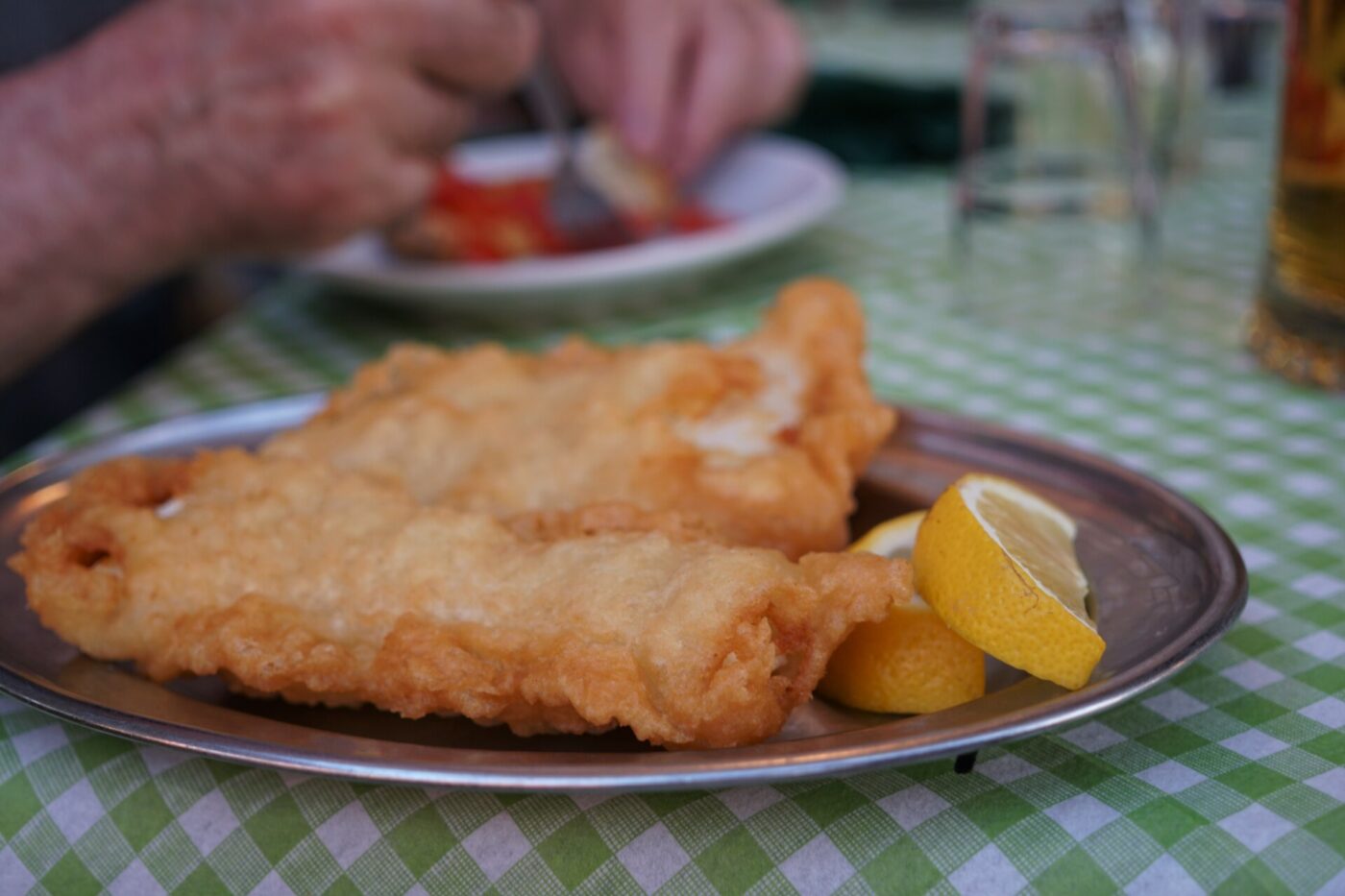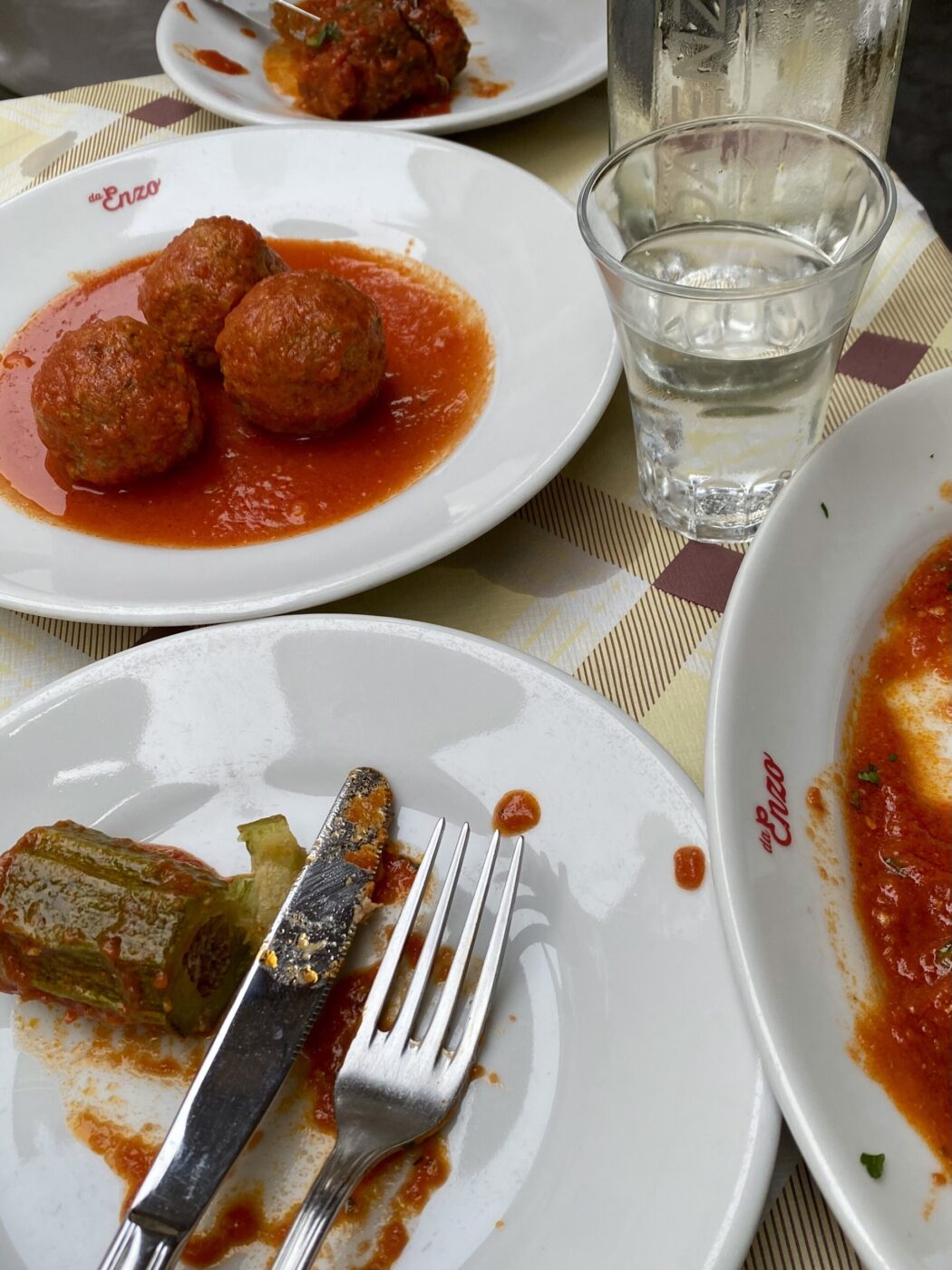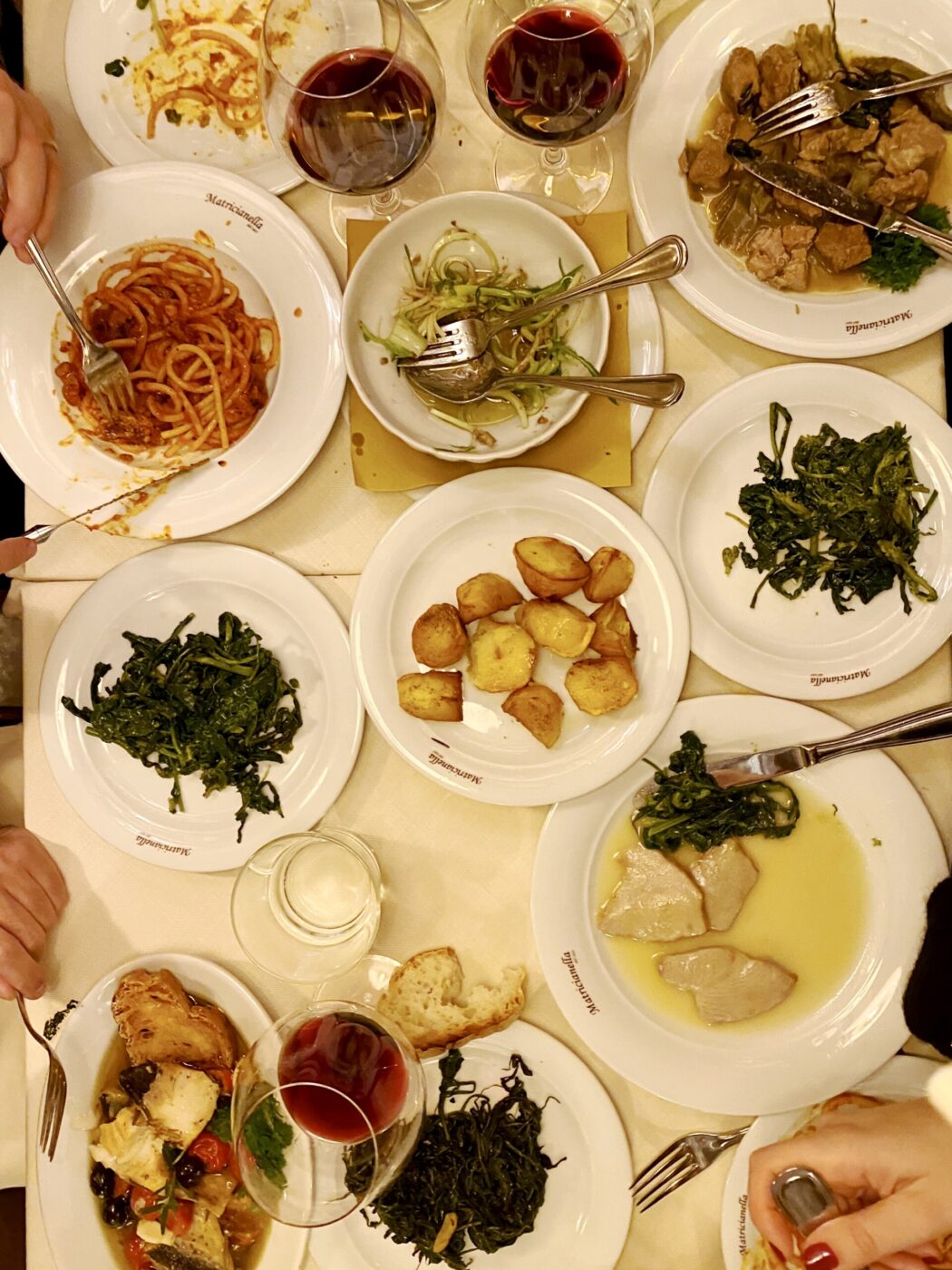Sure, it’s the capital of Italy, hosts Vatican City, and is the home of world-renowned sites like the Colosseum, Trevi Fountain, Piazza Navona, and the Roman Forum. But if there’s one reason to visit the chaotically charming mecca of Rome, it’s for the food. Here, vegetables are green, meat a key player, and dishes typically have no more than four or five main ingredients–yet are aggressively flavorful.
While the food of Rome’s counterparts like Naples, Genova, and Palermo were mainly influenced by other cultures, here, the city’s cuisine was created internally via the surrounding countryside’s pastoral traditions, the Jewish community–the oldest in Europe–and the Testaccio slaughterhouse. From the 19th to late 20th centuries, this mattatoio was the largest of its kind in Europe. Workers were often paid in animal scraps–the quinto quarto–which has now become the backbone of Roman cuisine. Sweet tomato, salty pecorino, fresh mint, and pungent black pepper, plus frying, all helped to disguise anything ~unsavory about the meat, and at least one ingredient from this list makes its way into every major Roman recipe today.
Locals find no need to veer from the classics, still adhering to traditions like Thursday gnocchi, Friday baccala, and Saturday tripe. Here, the best of Rome’s saucy, meaty, salty, and creamy, as well as where to get our favorite versions.
Aside from the places mentioned here, a complete list of our favorite Roman restaurants can be found in our article Roma a Tavola.
Carbonara
She needs no introduction. One of Italy’s most famed pastas, Roman carbonara has four ingredients and four ingredients only: eggs, Pecorino Romano, cracked black pepper, and guanciale (cured pork cheek or jowl). And, under no circumstances, does cream get added. It is undeniably creamy, however, because tossing hot pasta with raw beaten eggs and grated pecorino quickly cooks the yolks to form a glistening, luscious sauce. Pasta shape here is quite debated, but you’ll most often find the bright yellow sauce on rigatoni or spaghetti. The dish’s name comes from carbonaro, “coal burner,” which could point to the pasta’s origin as a hearty, easy meal for men working long hours on the job. It also bears similarity to pasta cacio e uova, a Neapolitan dish in Ippolito Cavalcanti’s 1839 Neapolitan cookbook of pasta with melted lard, raw eggs, and cheese; though, a 1950 article in La Stampa points its origin to 1944 Allied liberation of Rome, when American soldiers brought their daily ration of eggs and bacon to local restaurants to add to the limited postwar menus. It’s an easy dish to make at home, but if you haven’t tried the pasta in Rome, then you haven’t yet had a true carbonara.
Where to Try Our Favorite Version: It’s impossible to pick one… so here are our 10 favorite places.
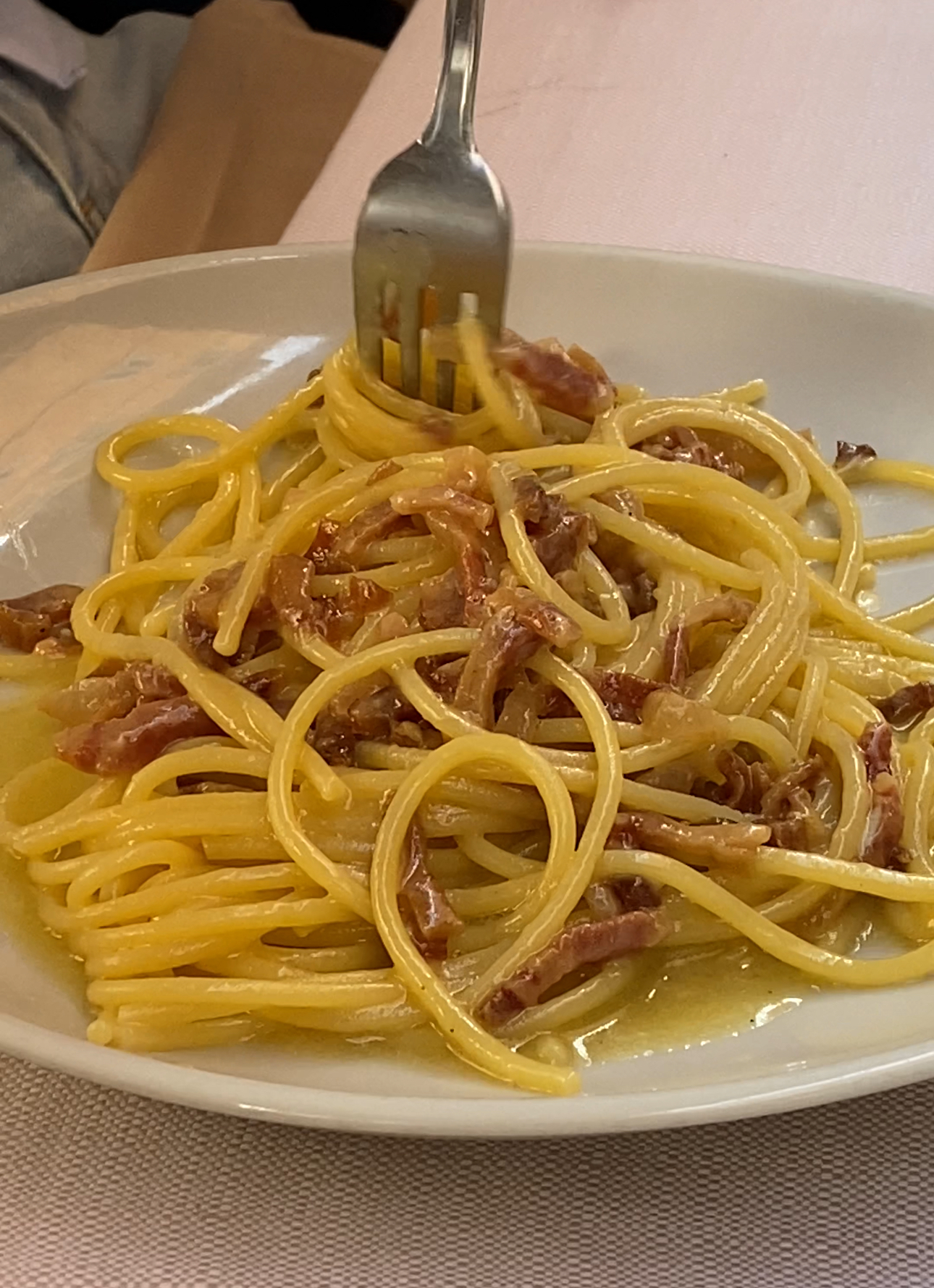
Amatriciana
The only sauce with tomato, pasta alla amatriciana delightfully holds its own as the lightest amongst Rome’s four main pastas. It has the usual base of guanciale and Pecorino Romano, plus tomato and a little black pepper, tossed most traditionally with bucatini–but you’ll find adamant supporters of rigatoni or mezze maniche instead. This dish’s origin story is more concrete: in 1592, the town of Amatrice near Rome was burnt down by the Spanish, and survivors fled south to Naples where the hottest culinary trend was just taking hold: tomatoes, brought to the peninsula by the aforementioned Spanish conquistadors at the beginning of that century. When they moved back to their hometown a century later, the people of Amatrice began adding tomatoes to their gricia, inspired by their hip southern friends. An 1861 cookbook called L’Apicio Moderno by Francesco Leonardi, chef at the court of Pope Pius VII, has the first recorded recipe, after he made the dish for a banquet in honor of Austrian Emperor Francis I. Since then, the recipe has remained unchanged–avoid any that call for onions, garlic, olive oil, or pancetta, unnecessary additions for Rome’s sauciest pasta.
Where to Try Our Favorite Version: Cesare al Pellegrino
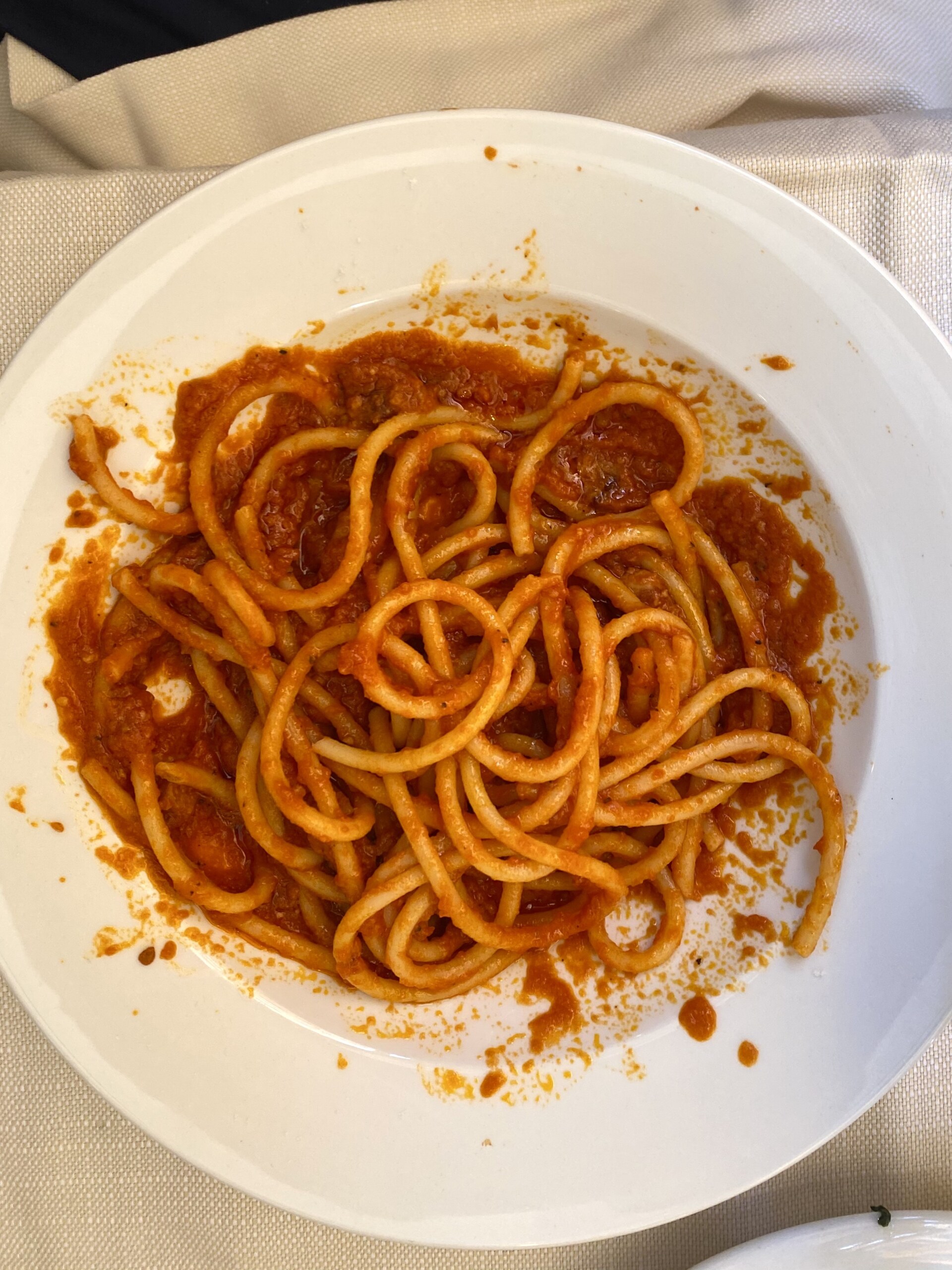
Cacio e Pepe
If an influencer was a food, she would be cacio e pepe. This cheesy girl is so beloved by her American followers that she was named “the coolest pasta dish of 2016” by New York Magazine. Nearly every Italian restaurant abroad serves a version, which gets ever increasingly glamourous as the pasta is swirled in huge wheels of parmigiano, and is even reinterpreted into pizzas, burgers, and more. But behind the theatrics is a stripped down pasta dish, made with just two ingredients–Pecorino Romano and black pepper, and certainly not butter–that’s deceptively simple and utterly delicious. It’s best on spaghetti or the local tonnarelli, a long square noodle, but rigatoni or mezze maniche will also suffice. Legend says that shepherds, who brought their own cheese out to the fields, created the dish, but with the high price of black pepper and the unpopularity of dried pasta, it’s somewhat debated. More likely, it was served in Roman taverns as a way to encourage patrons to drink, since they made a version so dry and spiced it had to be washed down with wine. Cacio e pepe’s popularity rose with Italy’s post-WWII economic boom, and then skyrocketed in the 21st century thanks to a certain Instagrammability.
Where to Try Our Favorite Version: Felice a Testaccio
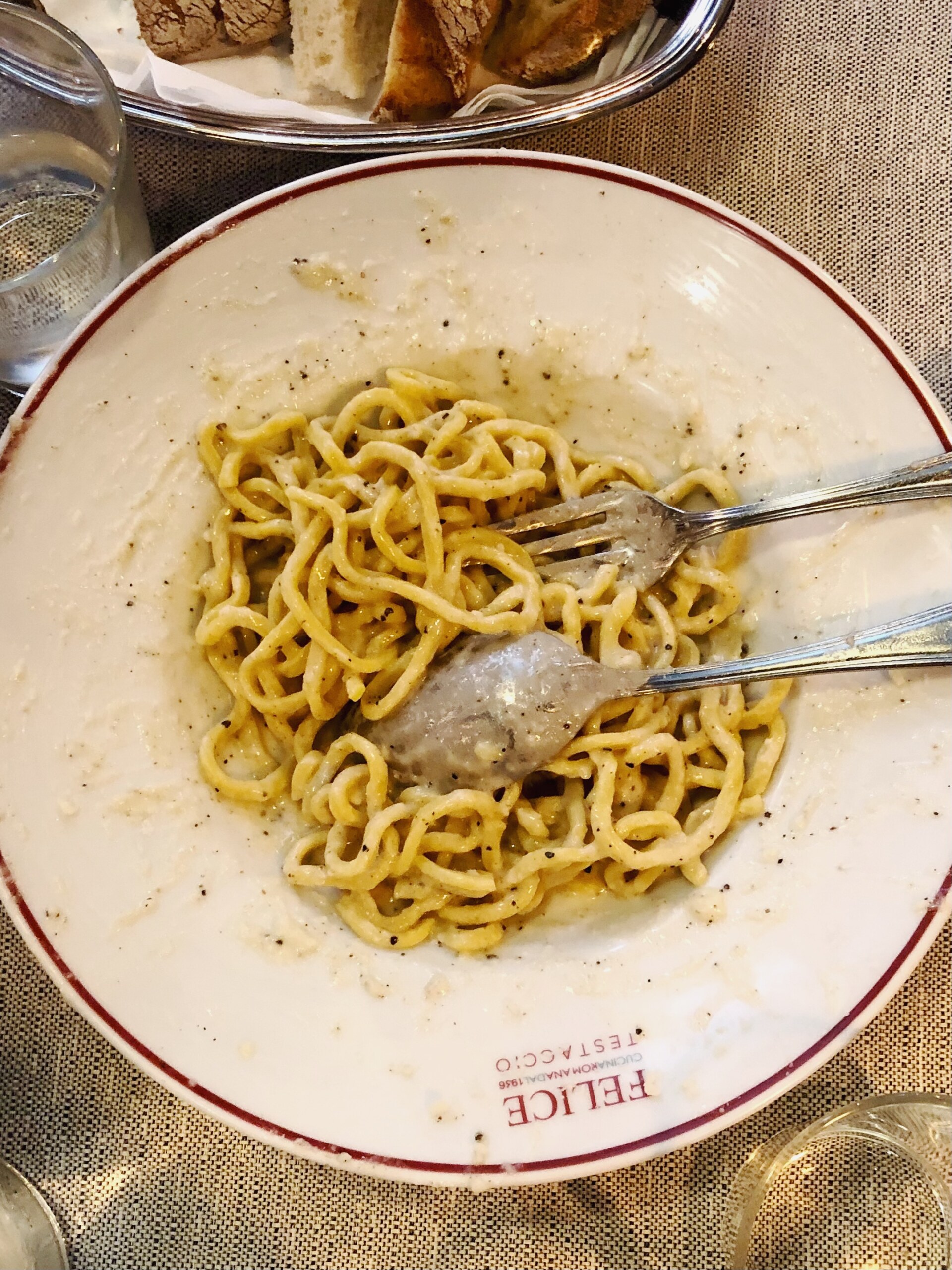
Gricia
Much like a mother, gricia sits far out of the spotlight that is showered upon her three children, carbonara, amatriciana, and cacio e pepe. But the humble dish that likely predates them all might be the most deserving of the limelight. Gricia features Lazio’s two star ingredients–salty Pecorino Romano cheese and fatty, fabulous guanciale (cured pork jowl)–atop al dente rigatoni. The dish’s origins are a bit fuzzy; some say it comes from the town of Grisciano, others from shepherds working in the fields following a story like that of cacio e pepe’s. The name is similar to gricio, a title for sellers of common food, among which guanciale and pecorino would certainly have been included. You’d be wrong to think it’s just a mixture of cacio e pepe and guanciale, it’s lighter on the cheese than cacio e pepe. It’s simple, yes, but since when has that been a bad thing?
Where to Try Our Favorite Version: Roscioli, Armando al Pantheon

Courtesy of Armando Al Pantheon
Rigatoni con la Pajata
This pasta dish gets much less attention than its aforementioned counterparts–likely due to tourists’ continued aversion to guts–yet is a favorite among Roman locals. Pajata is an intestine from an unweaned calf that still contains partially digested milk from its mother. When the intestine (which is washed and cleaned) gets cooked, the enzymatic rennet coagulates inside the casing. EATER compares the result to “a sausage casing stuffed with ricotta”, and you’ll most commonly find it cooked in tomato sauce and served with a shaving of Pecorino Romano atop ridged rigatoni. You might also try it grilled, but, as usual, the tomato and pecorino are quite nice additions.
Where to Try Our Favorite Version: Santo Palato
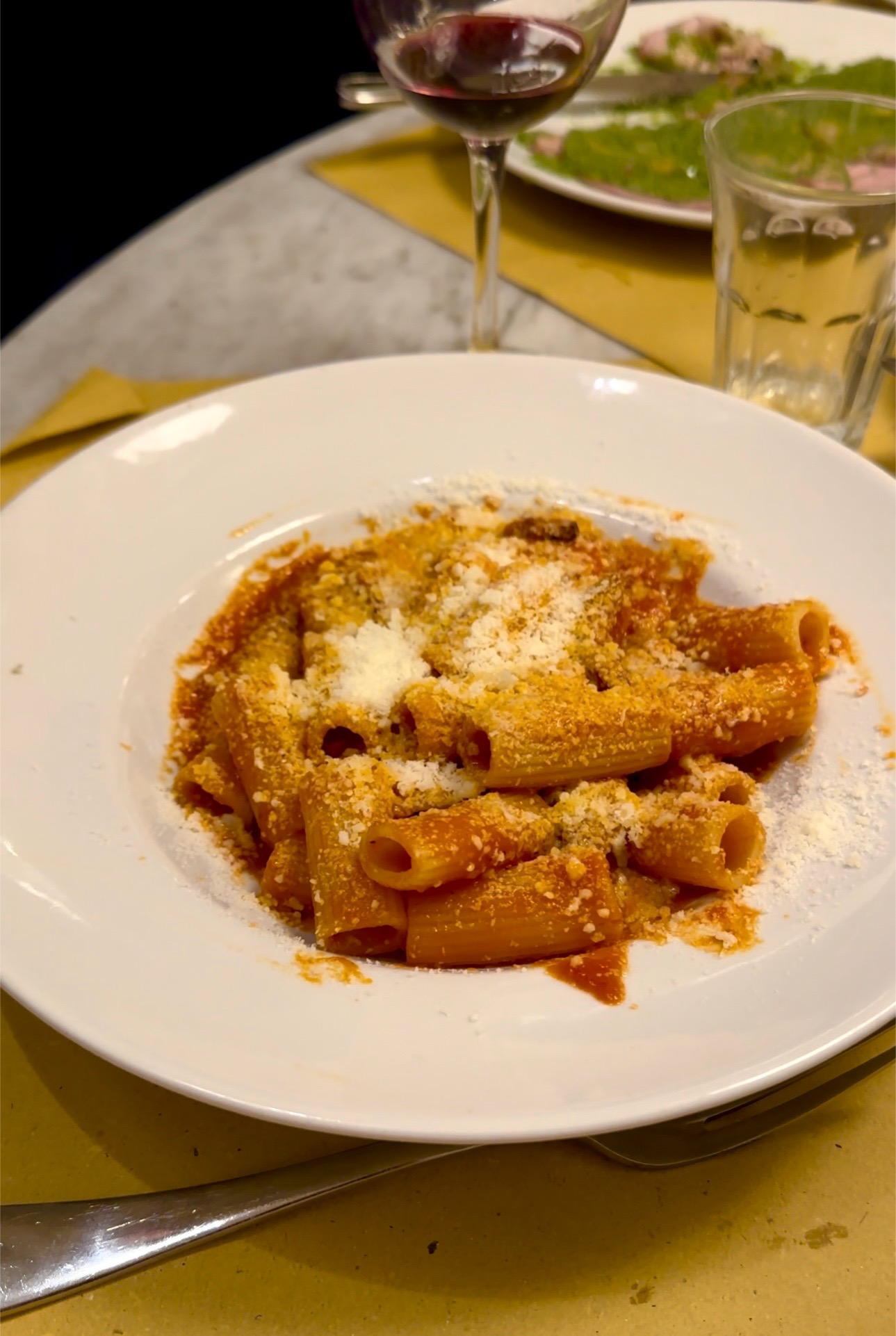
Carciofi
With a crown-like shape, it’s no surprise artichokes are the reigning vegetable of this capital city. Since ancient times, they have been foraged in the Lazian countryside, and became widely popularized with the rise of the Jewish community here. Many varieties of the globe flood market stalls and tables from December to April, prepared in two main–and exceptionally delicious–ways. For carciofo alla romana, artichokes, particularly the IGP Romanesco variety, are simmered with garlic, fresh mint, and lemon for a delightfully soft, aromatic result. On the other hand, carciofo alla giudia, “artichokes Jewish-style” in Roman dialect, are made by frying an entire flower-shaped bulb until they’re incredibly crispy. The preparation emerged during the 16th century in the city’s Jewish ghetto and is best made with the Romanesco cimaroli or mammole varieties–less thorny and without the pesky choke. Many locals and restaurants have their own versions of the two, but with artichokes this good, you’re guaranteed a standout dish wherever and however you enjoy it.
Where to Try Our Favorite Version: Nonna Betta, Ristorante Piperno
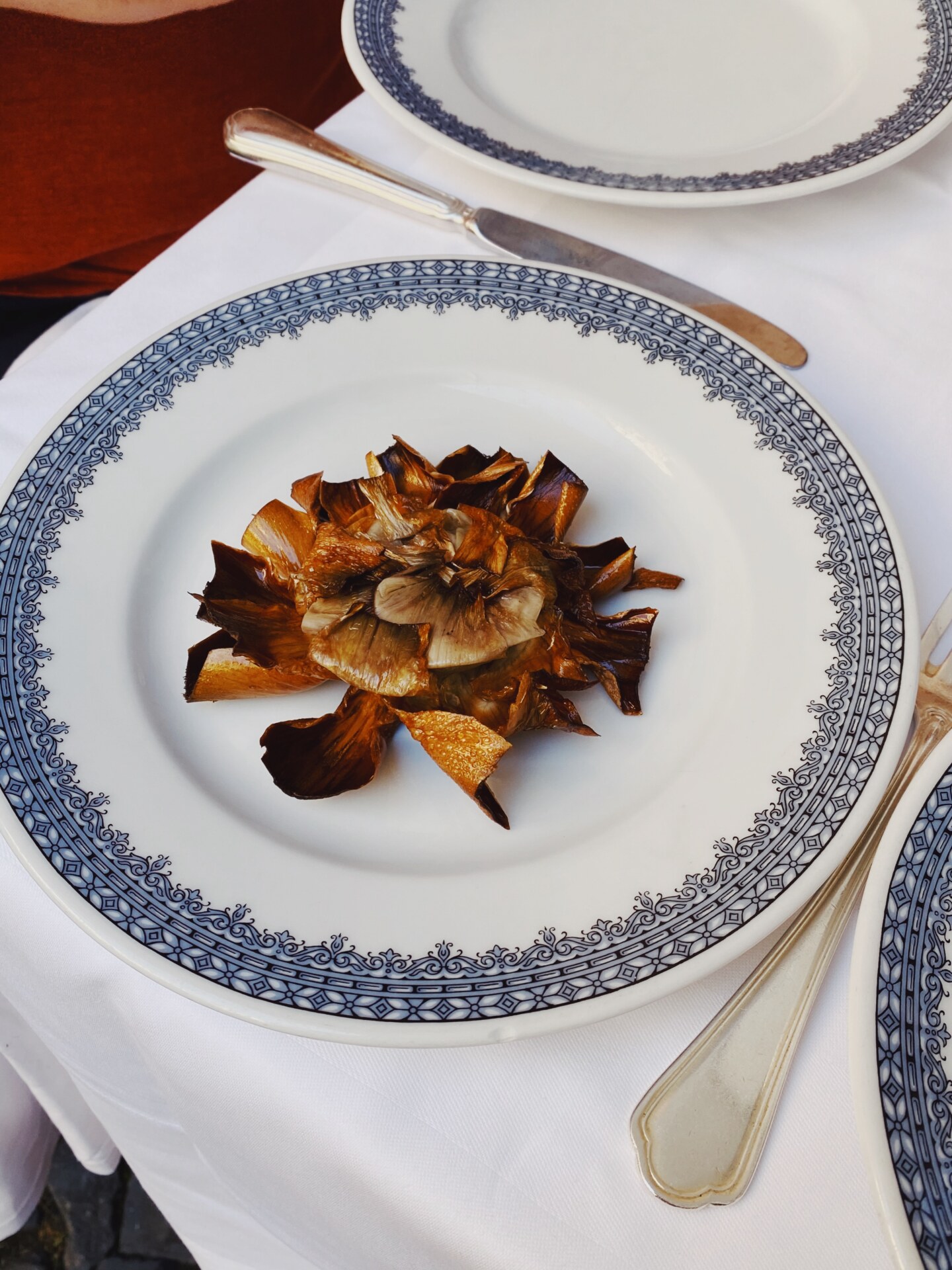
Maritozzo
There’s something uniquely delightful about sinking your teeth into the sweet cloud that is a maritozzo: a soft, yeasty bun overflowing with a sumptuous mound of whipped cream. If that description didn’t sell you, its lavish appearance neatly lined behind glass counters certainly will. Once an iconic breakfast choice in Rome during the Dolce Vita era of the 50s and 60s, they faded into the background with the rise of cornetti. Before then, a stripped down version existed even in Ancient Rome. The pastry is sweet not just for its ingredients, but because it’s also a symbol of love–the name comes from the word for husband, marito. In the 19th century, Roman men would propose to their partners on the first Friday of March by hiding a ring in a maritozzo. In another story, young women would bake a heart-shaped version of the treat and present it to the most handsome young man in the village on Colle Oppio, an ancient hill near the Colosseum; he would then wed the woman who baked the best one. Be sure to snag the mouthwatering, messy delight for a sugar-rush inducing breakfast, perfect for fueling your day exploring the Eternal City.
Where to Try Our Favorite Version: Pasticceria Regoli

Pizza Rossa
Pizza might just be the most eaten food in Rome. But we’re not talking about the fluffy, high-crusted type from Naples–Roman pizza is either al taglio (by the–square–slice) or tonda (round), and both are thinner, sturdier, and crunchier than their southern twin. Pizza rossa is our favorite flavor of the two, with a thin layer of sweet tomato spread atop the light dough. It’s best al taglio, when an employee cuts a slice right from the long rectangular tray, weights, reheats, and hands you the slice wrapped in wax paper to eat immediately or while walking–hypocritical, we know. Aside from rossa, the best are bianca, with salt and olive oil, or con patate, with thinly sliced potatoes and rosemary. Grab a slice (or two!) at any time during the day, from breakfast to merenda to a late night snack, if the forni have any left by then.
Where to Try Our Favorite Version: Forno del ghetto, Forno Campo de’ Fiori
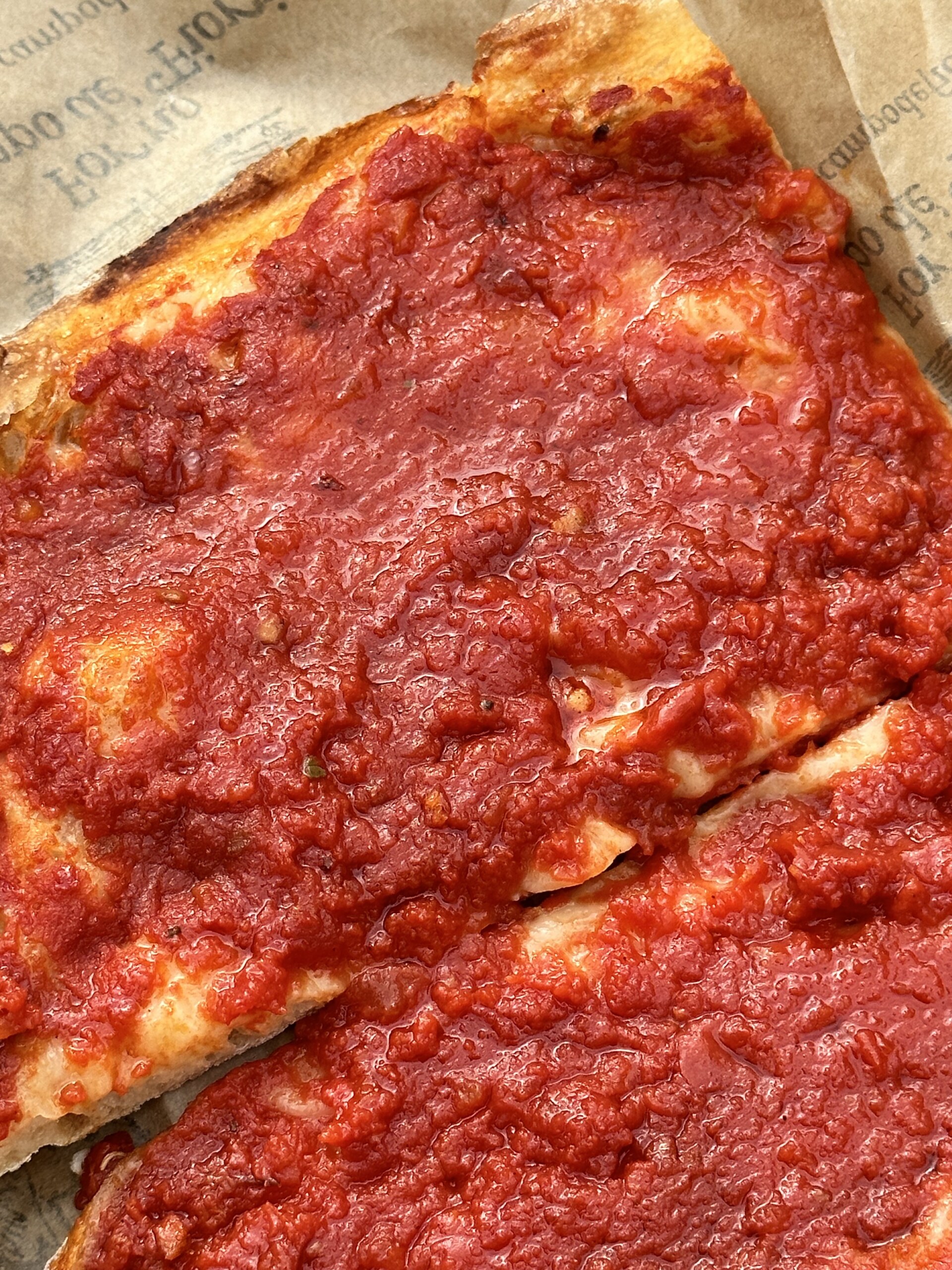
Supplì al Telefono
Supplì are similar to arancini–in that they’re rice rolled into a ball, bread crumbed, and fried–but more oblong than the circular and triangular Sicilian versions. Traditionally, the rice is streaked with ragù–best when it’s made with oxtail–and formed around a piece of mozzarella. Eat one straight out of the fryer, when the coating is extra crispy and the cheesy heart is perfectly melted: when you take a bite, the mozzarella oozes and forms a “telephone wire” string of cheese, earning these golden globes their full name. The “supplì” part, however, comes from the 19th century, when Napoleon’s troops used the French term “surprise” to describe the fried Roman product. From surprise, it morphed into the Roman variation “suprisa”, then “supprisa”, “supprì”, and finally supplì. Today, supplì come in all types of flavor combos, and the best place to get one is where you can smell it first.
Where to Try Our Favorite Version: Ristorante L’Arcangelo
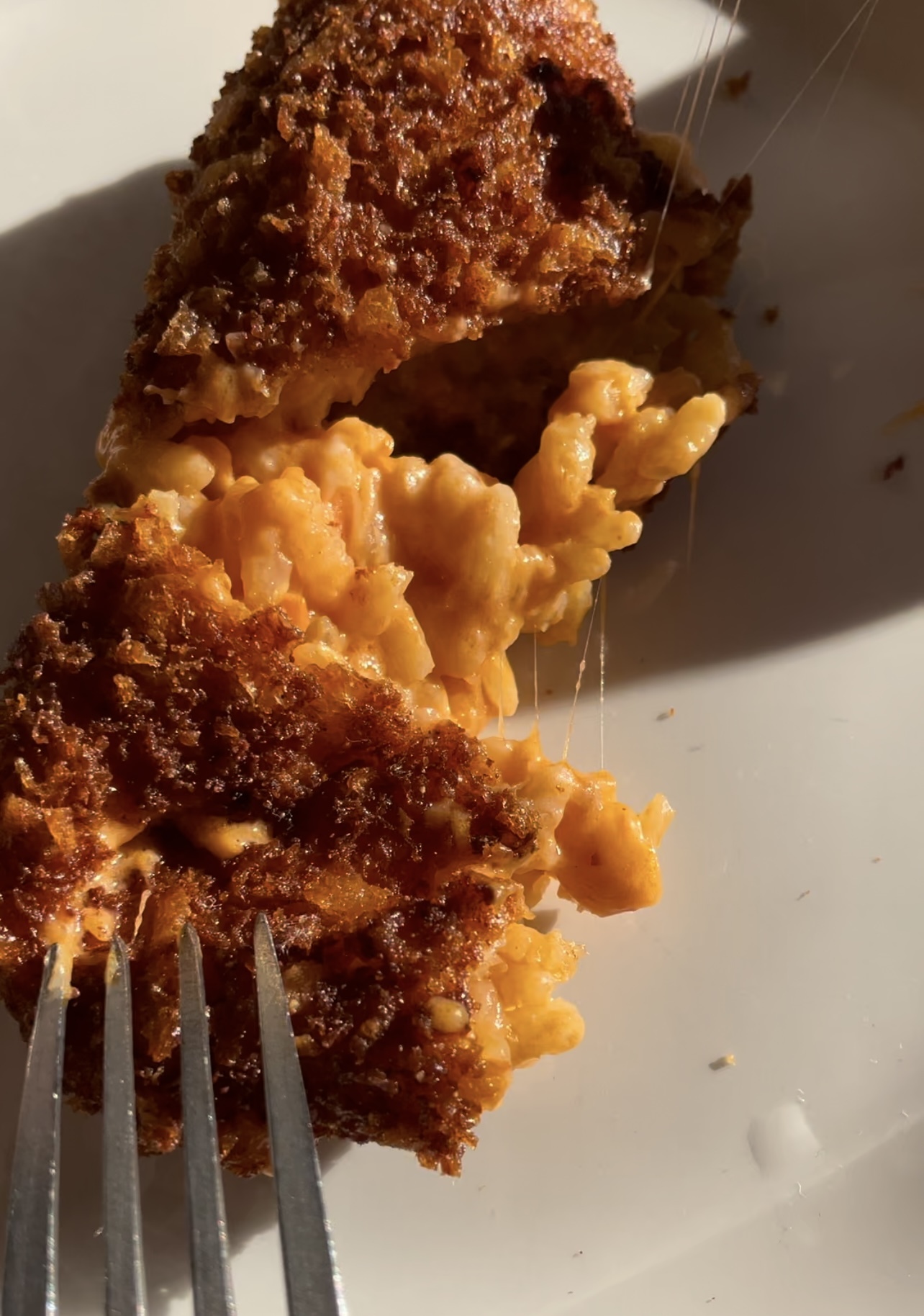
Puntarelle
Grown in abundance in the Roman countryside, these “little points” are the crispy, crunchy, and remarkably fresh stalks of the Catalonia chicory. The spiky foliage is reminiscent of dandelion greens, a bit bitter and requiring a fiddly process to strip the leaves, reveal the slender shoots, and soak them until they curl. These loose green coils have been eaten since the times of Ovid and Pliny, who praised the vegetable for its outstanding positive health benefits. Emperor Caesar, too, favored the greens, eating them in a form of salad with garum–fermented fish sauce–that predates the international obsession named after him today. In Rome, they’re served in a similar manner to how Emperor Caesar ate them, tossed with a dressing of olive oil, red wine vinegar, and a puree of garlic and anchovies. The vitamin-rich greens are perfectly snappy, complemented by the sweet saltiness of the sauce. If you’re buying them to make at home, many markets are stocked with pre-prepped, curl-ready puntarelle.
Where to Try Our Favorite Version: Da Teo
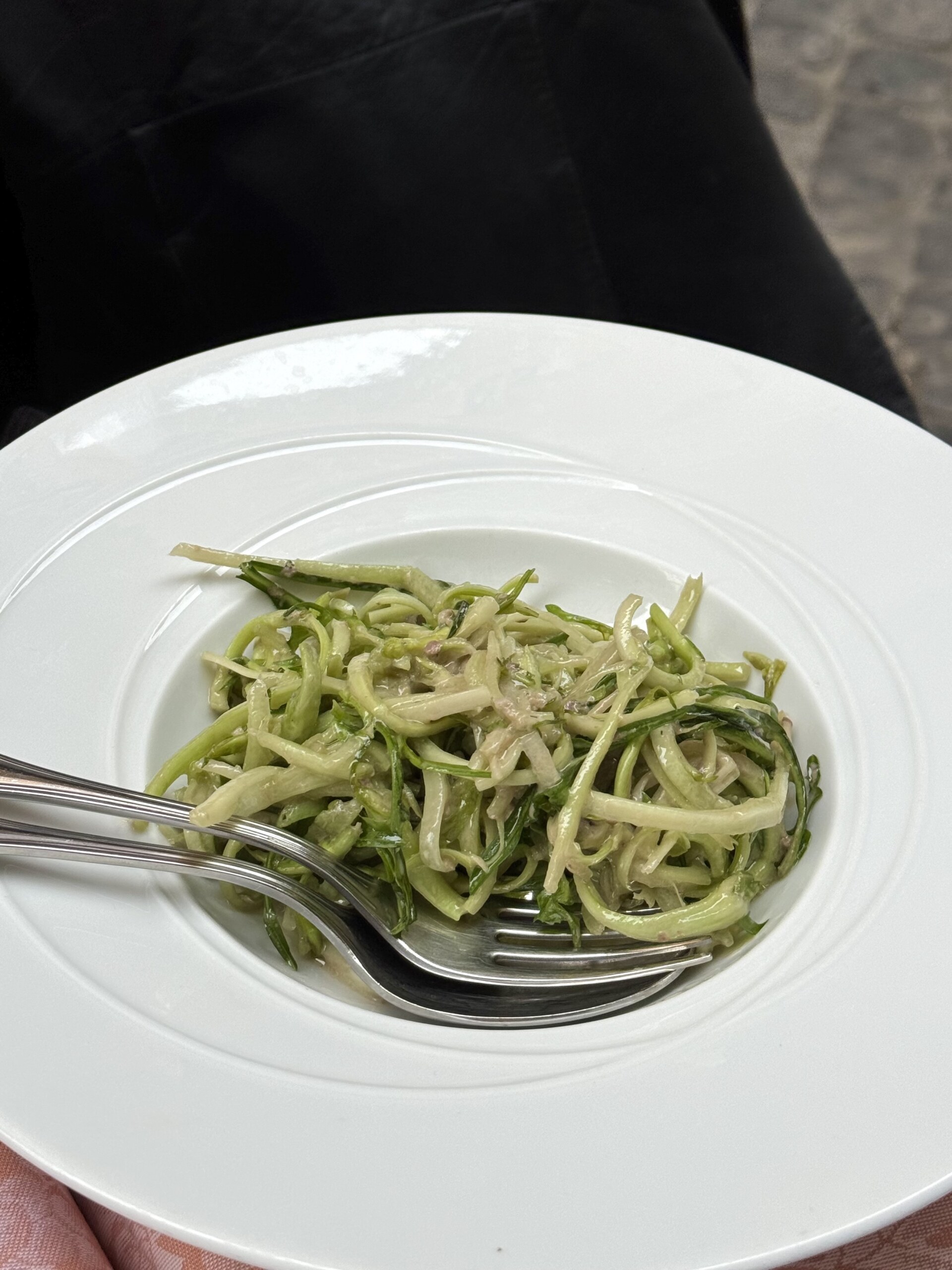
Saltimbocca alla Romana
This Roman-style veal is so good it saltimbocca, or “jumps directly into your mouth”. The recipe was first recorded by icon Pellegrino Artusi in his 1871 book “Science in the Kitchen and the Art of Eating Well”, who mentions eating it at Le Venete in Rome. Brescia in Lombardy technically claims the invention of this dish, yet the name–alla Romana–reminds eaters that it’s become entirely Roman. Very thin, tender slices of veal are topped with a slice of prosciutto crudo and half a sage leaf–a whole one would be too overpowering–held together with a toothpick, dusted in a touch of flour, browned in butter and white wine, and served hot with a bit of salt and black pepper.
Where to Try Our Favorite Version: Armando Al Pantheon
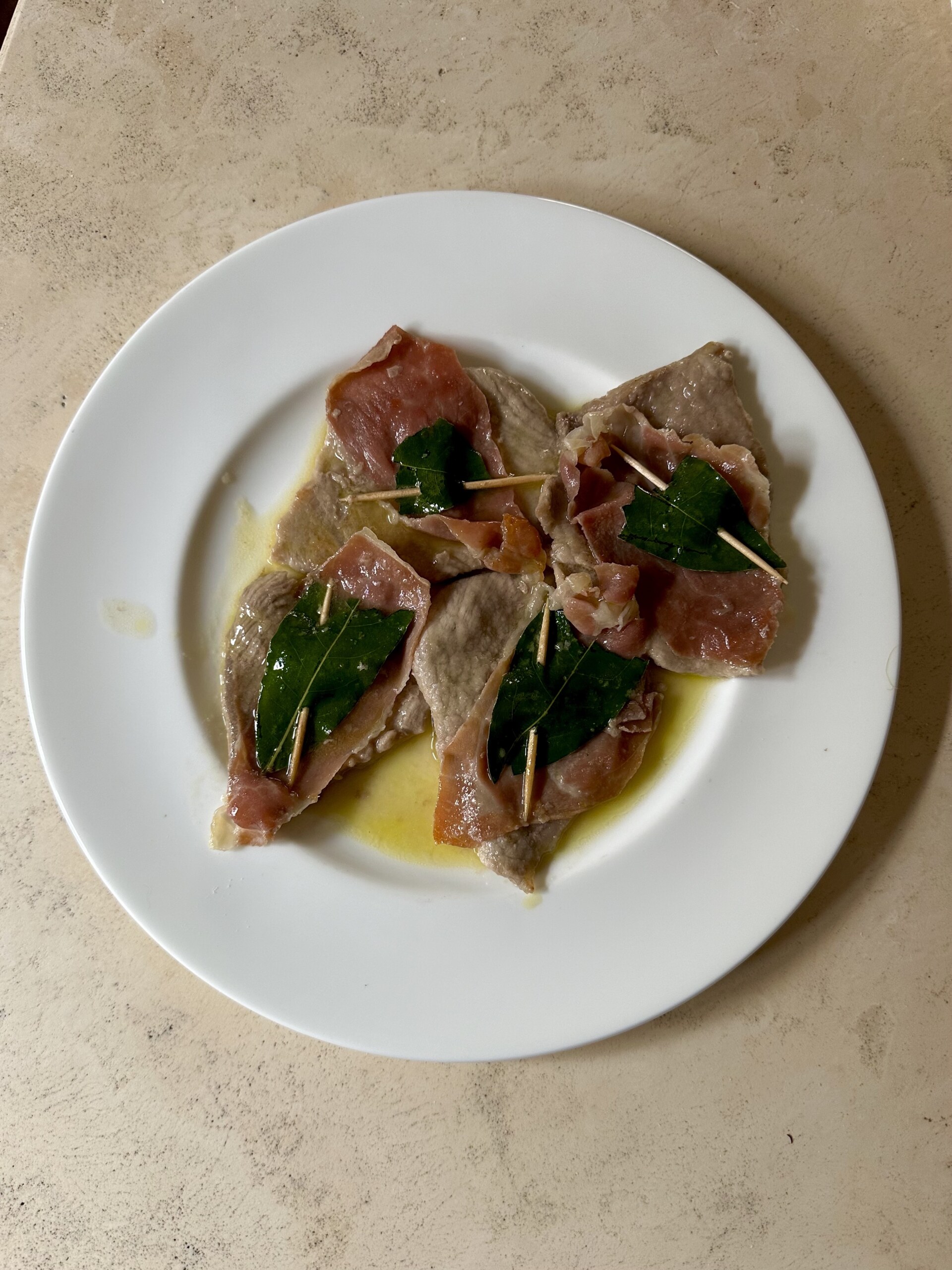
Pollo con i Peperoni
This slow cooked chicken dish is as synonymous with Ferragosto as estate italiana is and was once traditionally made by Romans across the boot to celebrate the August holiday. The official recipe came about in the 60s when Elena Fabrizi, aka Sora Lella, told Gigi Ballista her recipe on the Rai program “Linea contro linea”. It seems to have originated in the Castelli Romani outside the city center, and its three-ingredient recipe of a whole chicken, peppers, and tomatoes is mostly unchanged. The chicken is browned with a bit of salt, pepper, and white wine, and left to stew with the peppers and tomatoes, making a bright, sweet, and tender secondo–always served with a large hunk of bread to sop up all the juices.
Where to Try Our Favorite Version: Osteria Chiana
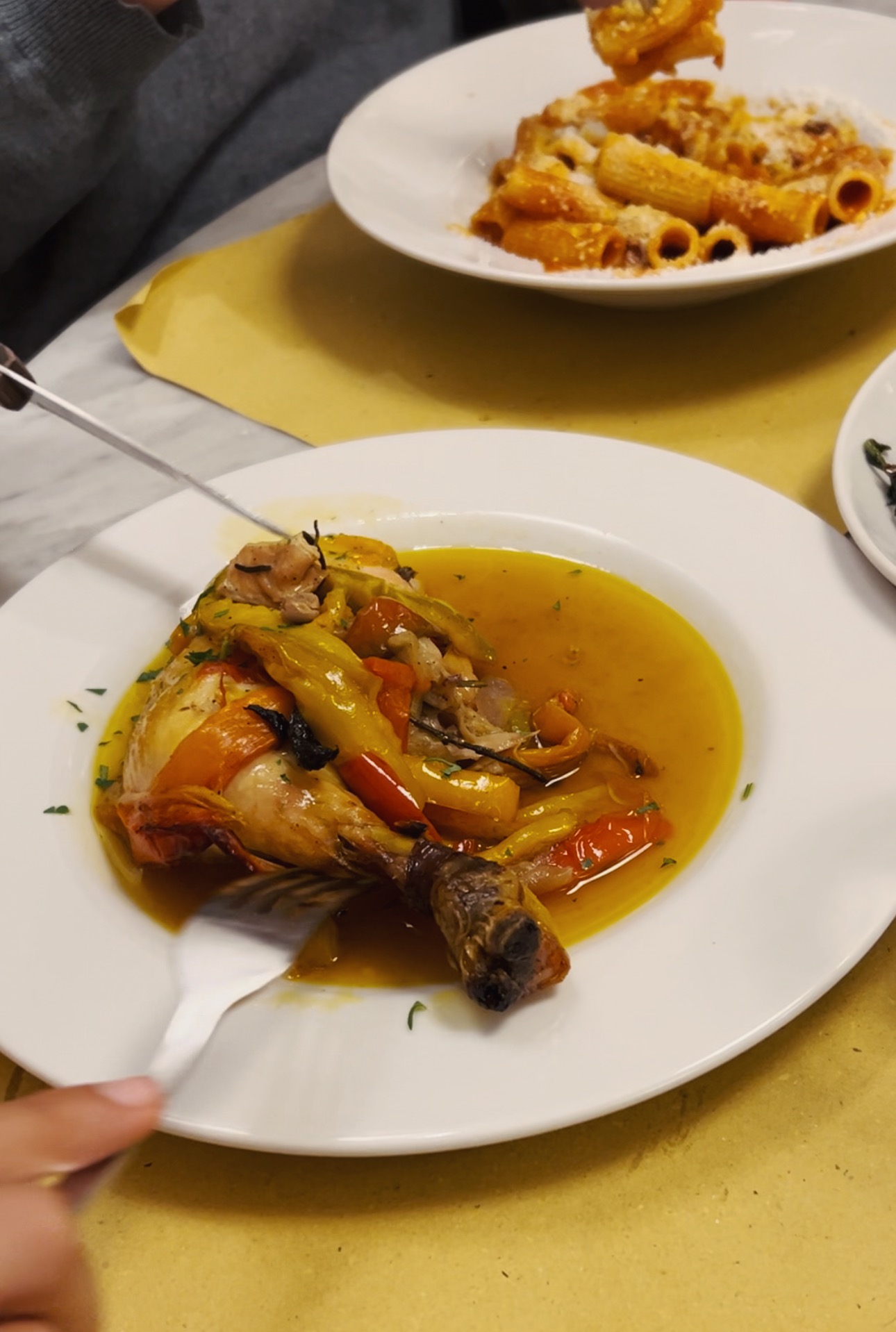
Trippa alla Romana
“Saturday Tripe” is how the Romans know this dish, as it’s enjoyed on that day both in trattorias and also at home. To make Rome’s superlative version of trippa, cow stomach is boiled and then stewed in tomato puree and a sautèed soffrito of celery, carrot, and onion, then topped with funky Pecorino Romano, fresh mint, and plenty of salt, pepper, and peperoncino. This flavorful secondo disguises its origins in peasant kitchens, and the pecorino and mint combo still has yet to be beaten by other Italian preparations of the bovine’s stomach.
Where to Try Our Favorite Version: Piatto Romano
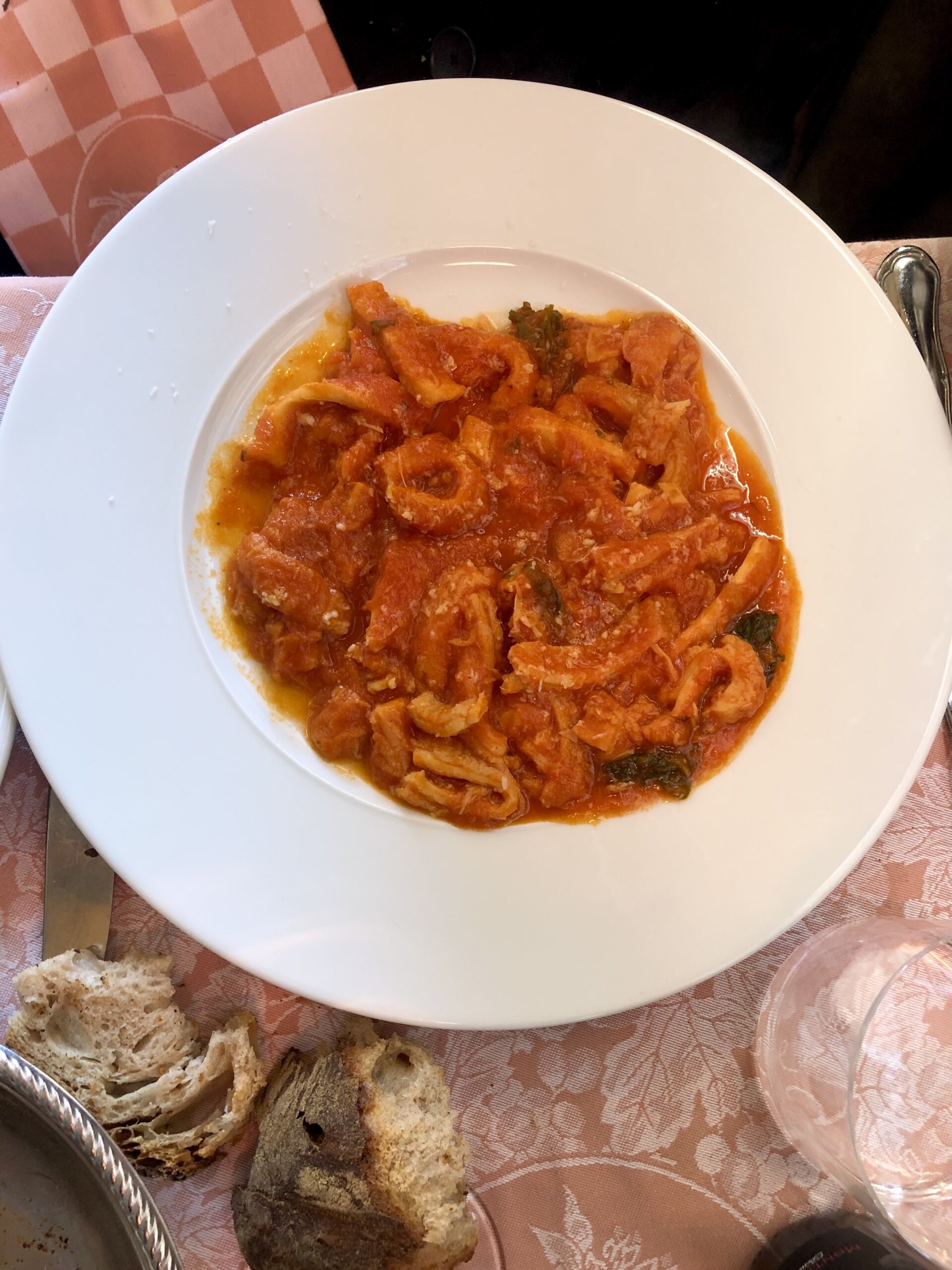
Vignarola
Come springtime, this veggie-forward dish shines like an emerald on Roman menus. Vignarola is a warm salad of fava beans, artichokes, peas, romaine, guanciale, mint, and Pecorino Romano, though it can be made vegetarian by subbing an extra glug of olive oil for the guanciale. Some versions add spring onions, asparagus, or other spring vegetables, plopping the creation atop lamb, pasta, and toasted bread for bruschetta, though it’s also great on its own. The name vignarola was what the fruttivendoli were once called in ancient Rome, and legend says they likely made a similar dish with whatever vegetables they didn’t sell, using the guanciale and pecorino to add flavor and protein. Another story, though, points to the Velletri area, saying that winemakers in the Castelli Romani cooked whatever they found growing wild between the rows of vines, inventing this simple, but nutritious and tasty, dish.
Where to Try Our Favorite Version: Trattoria Al Moro
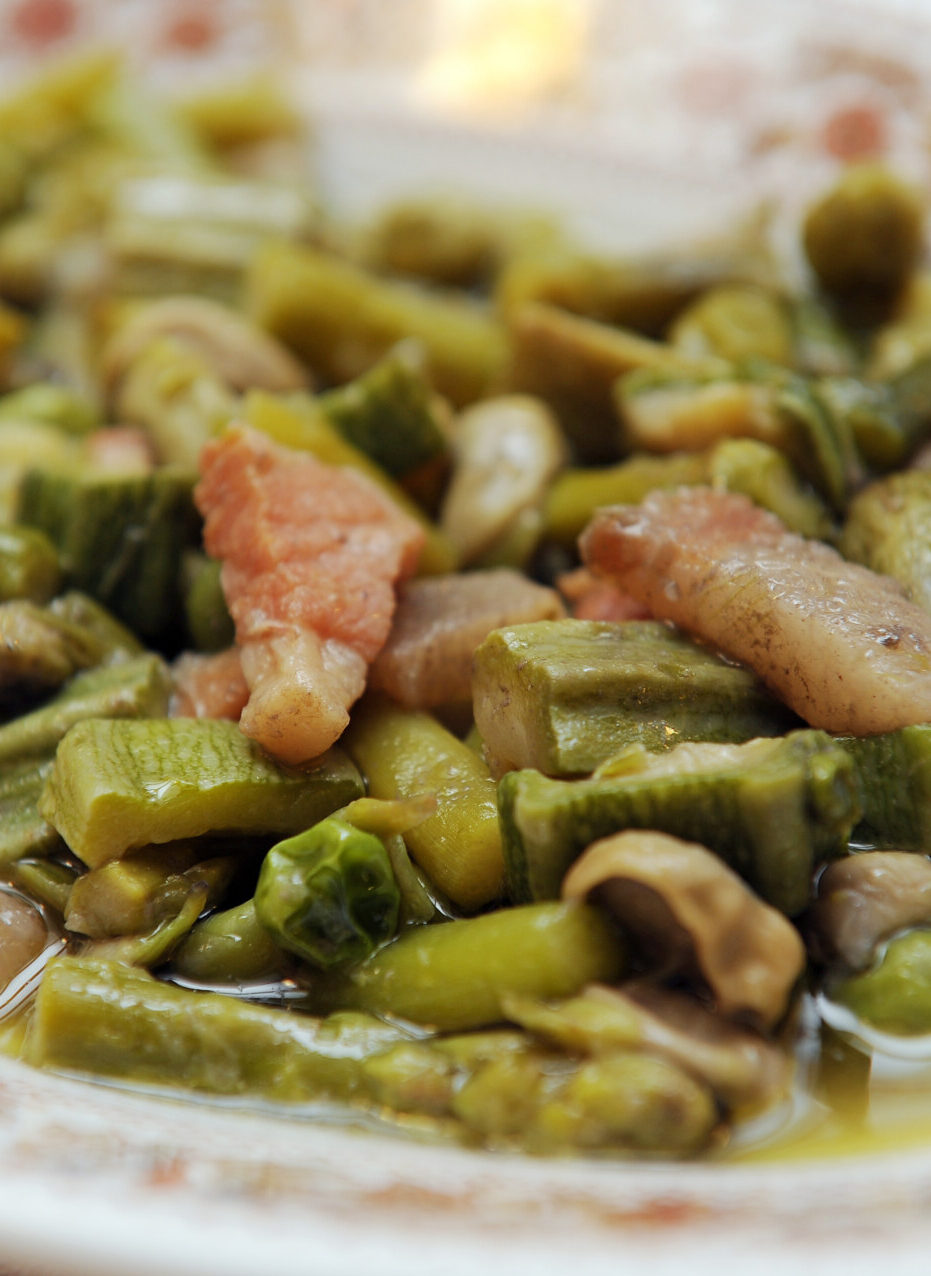
Broccolo Romano Ripassato
Those who grew up in Italy eagerly await the winter arrival of the bright green, swirly, pointy broccoli, while American visitors know it as romanesco and rarely find this alien-like vegetable. Here, the look is as surprising as the taste: sweet and mild, great on its own or a worthy addition to a simple pasta. It’s most often a side dish made ripassato: boiled until tender, then sautèed in a bit of garlic, red pepper, oil, and, if you like, anchovy. The aforementioned American visitors might find it a bit mushy, but for a country that rarely has a vegetable on a menu, we’re big fans.
Where to Try Our Favorite Version: Le Mani in Pasta, Osteria Der Belli
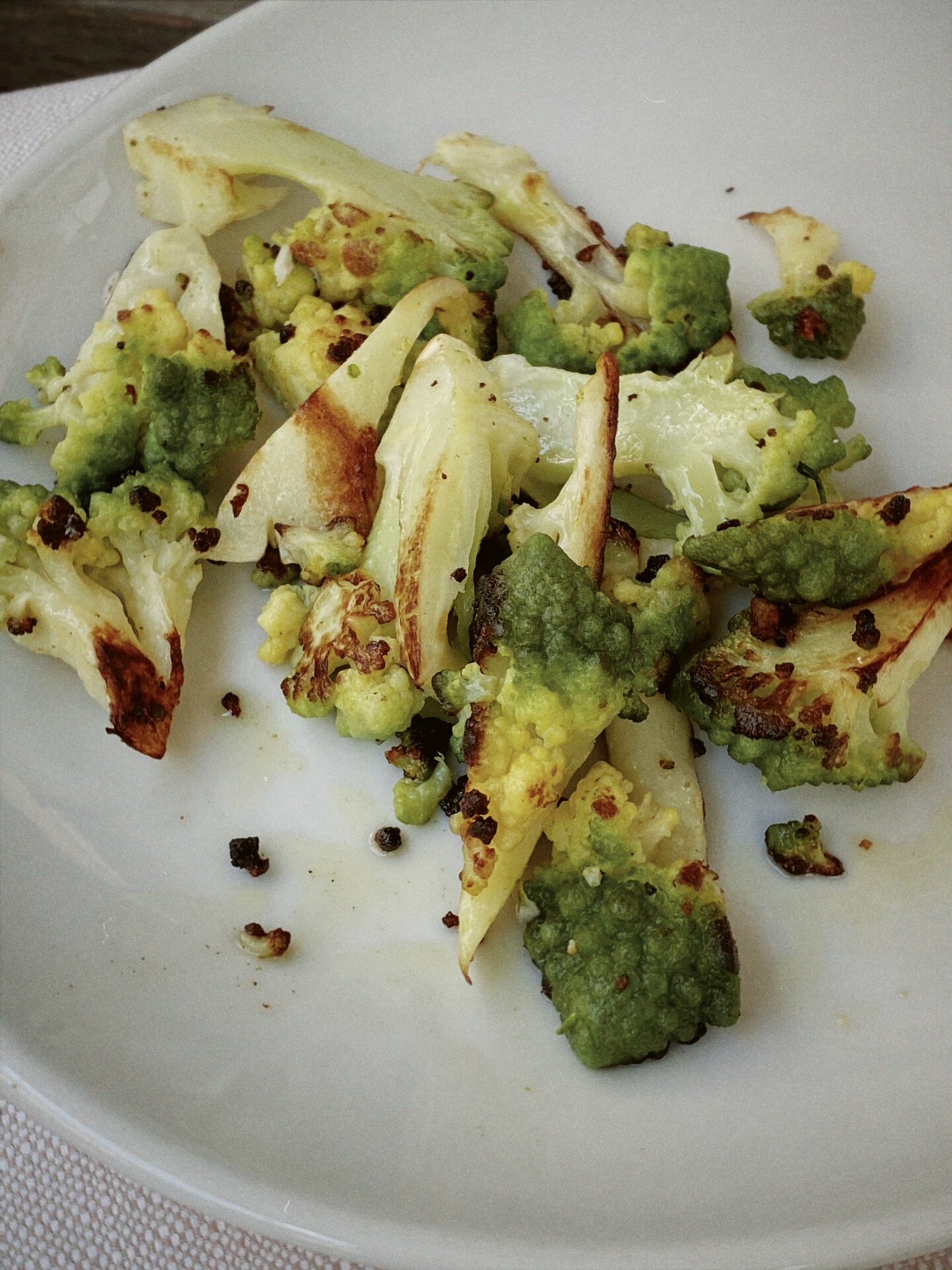
Broccolo Romano Ripassato, Le Mani in Pasta, Rome
Torta alla Visciole e Ricotta
Sour cherries, smooth ricotta, and crumbly pastry: this dessert emerged some 2,000 years ago with the arrival of the Jewish community in Rome. Still found in every pasticceria in the Jewish Quarter, the tart has become symbolic of the resourcefulness of the Jewish people in the face of oppression. In the 18th century, a papal decree–one in a long line of Vatican-dictated restrictions–banned the Jewish community from selling cheese and dairy products. Up until then, the tart had been made like a normal Italian crostata. But after this decree, a top sheet of dough was added on top to hide the ricotta interior, allowing the tart to be sold without suspicion. It’s still served with this double layer of shortcrust pastry that perfectly frames the creamy ricotta and tart cherry jam within.
Where to Try Our Favorite Version: Pasticceria Boccione

Coda alla Vaccinara
You’ll find this comfort classic in nearly every Roman trattoria. The name, “oxtail, tanner style” is because it was supposedly invented by leather workers in the 17th century. Oxtails are fatty and quite tough, but a lengthy braise makes them as tender as short ribs. The tails are stewed in tomato and an overwhelming amount of celery, plus carrots, onions, garlic, and pancetta. Flavor bombs like pine nuts, raisins, cinnamon, bay leaves, parsley, rosemary, thyme, white wine, cloves, and even cocoa powder are sometimes added, creating a rich sauce that permeates each bite of meat. The resulting rich, thick sugo is tossed with pasta, and the hunks of oxtail are served afterwards as a fall-off-the-bone secondo.
Where to Try Our Favorite Version: Dal Cordaro

Abbacchio alla Scottadito
Abbacchio romanesco–abbacchio is the Roman dialect of agnello, lamb–is sweeter and less gamey than most lamb, since it must be a suckling lamb slaughtered before it reached 7 kilos. Pink and tender, the city’s favorite way to eat it is alla scottadito. These little chops are grilled at a very high heat until perfectly charred, then served immediately. It’s one time when the Galateo goes flying out the window, and you’re meant to eat with your hands, but the little chops are so hot that they immediately scottadito, or burn your fingers. Abbacchio is also made al forno–roasted with potatoes–and alla cacciatora–cut and braised with garlic, wine, and anchovies–though alla scottadito remains the most fun.
Where to Try Our Favorite Version: Cesare al Casaletto, Trattoria Da Enzo Al 29
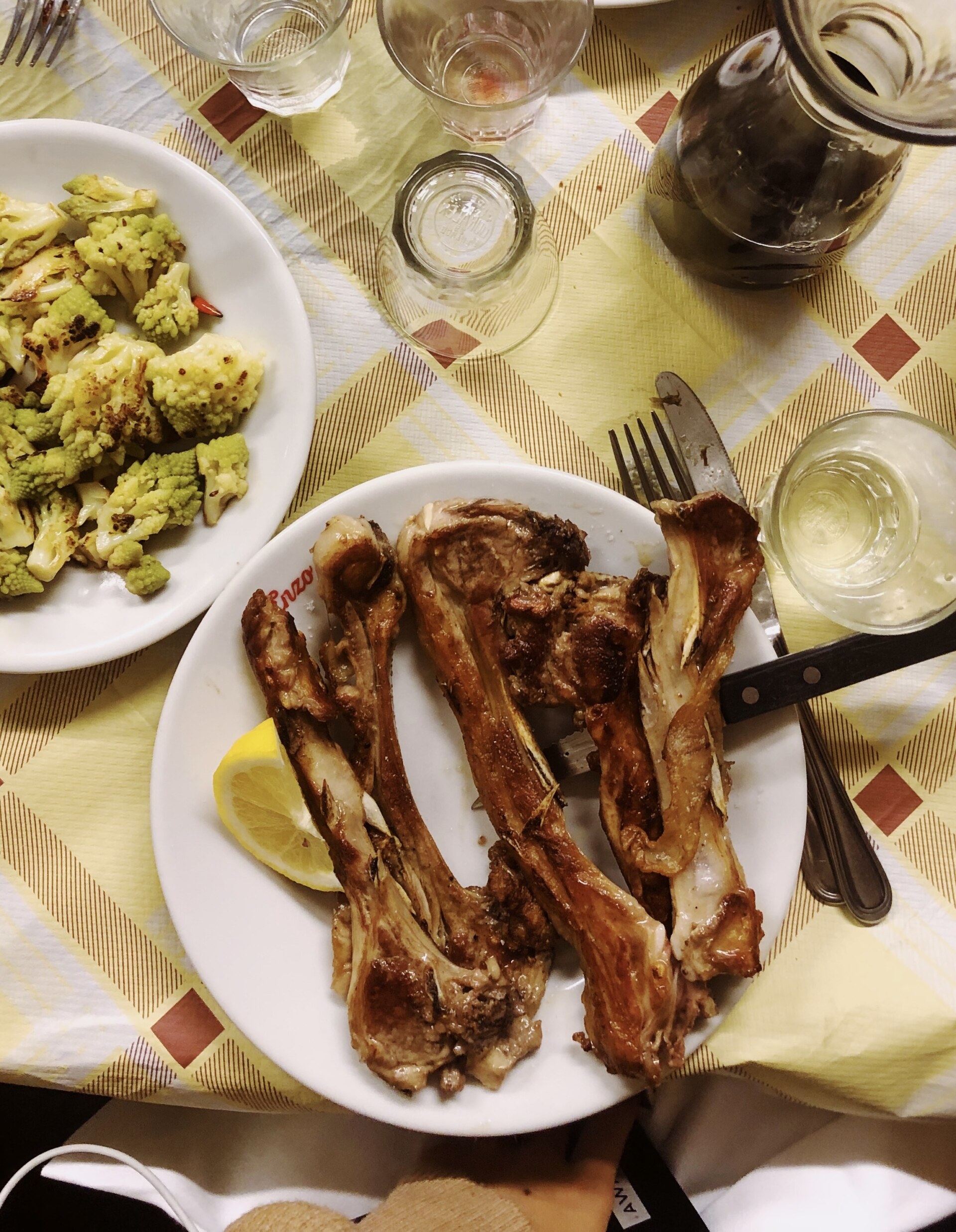
Filetti di Baccalà
Salted, battered, and deep fried. There’s nothing not to love about filetti di baccalà (as long as you like seafood, of course). The reigning king of Roman street food (aside his queen, supplì), the scent of frying filetti di baccalà wafts through the streets at all hours of the day–and night. Even in the Roman Empire, ambulatory vendors would walk streets, bathhouses, and amphitheaters selling fried fish and other on-the-go snacks. The tradition of frying really became embedded in Roman culture in the 16th century in the Jewish Ghetto, however, when inhabitants would fry fish and vegetables in communal vats–a cheap, easy, filling (and entirely kosher!) meal. Now, filetti di baccalà is commonly grabbed as a quick lunch or eaten as an antipasto at a Roman pizzeria–though it also makes a perfect midnight snack when you’re hitting the town.
Where to Try Our Favorite Version: Dar Filettaro a Santa Barbara
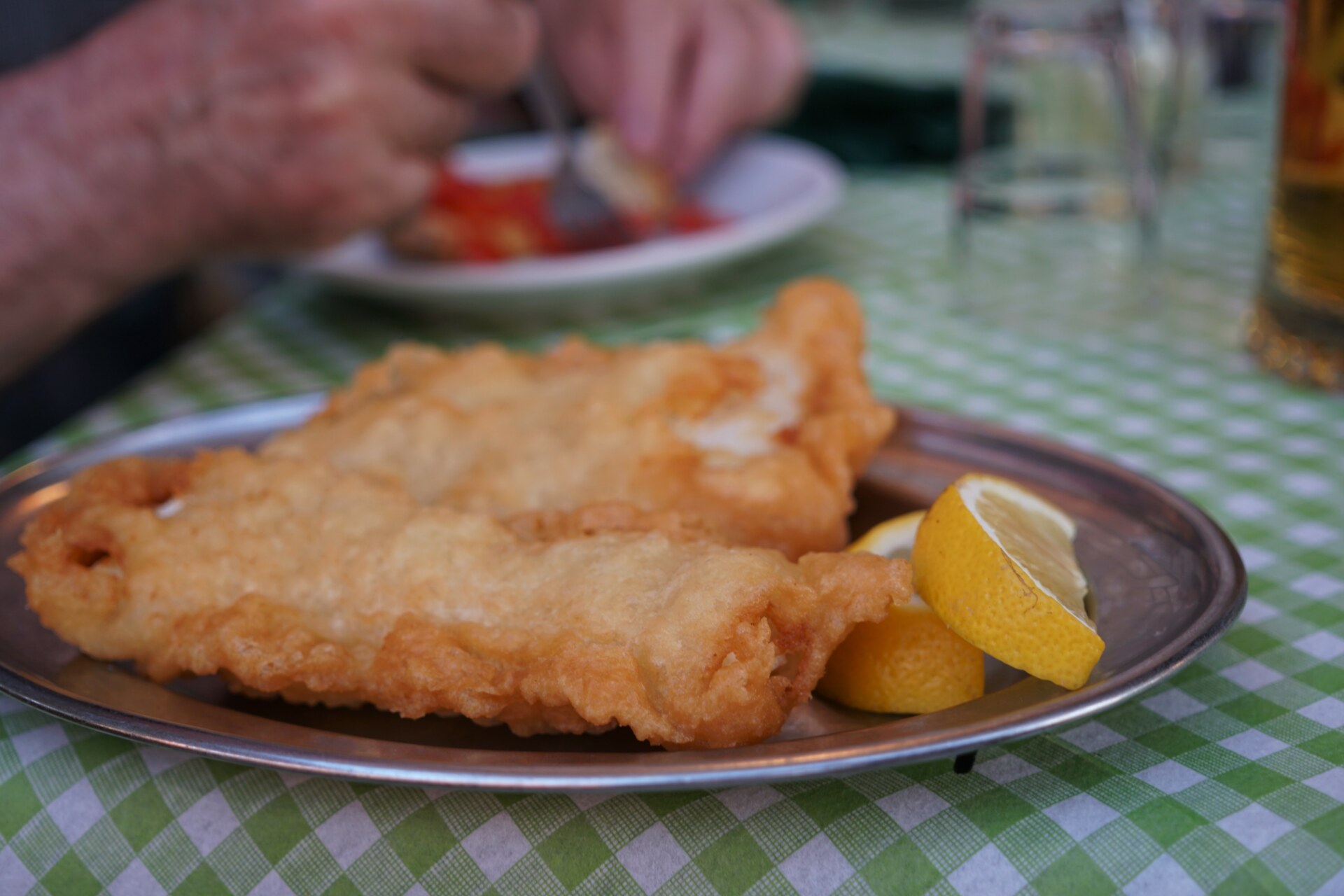
Polpette di Bollito
Bollito, literally “simmered or boiled beef”, is another meaty staple the Romans can’t seem to get enough of, colloquially known here as allesso. While, historically, nice cuts of beef were served on the tables of the wealthy, the poor were stuck with tough, unwanted pieces that could only really become edible through long boiling. To add flavor, the beef would get simmered in a rich broth, then chopped up and served on a roll or with potatoes. Our favorite way to eat bollito is as polpette, shredded, rolled with breadcrumbs and aromatics, and fried. Crunchy on the outside and soft on the inside, these polpette are best when dipped in a salsa verde of parsley, capers, anchovies, and garlic.
Where to Try Our Favorite Version: Cesare al Pellegrino, Trattoria Da Enzo Al 29

